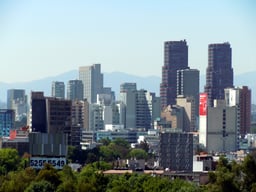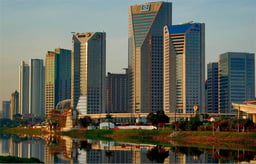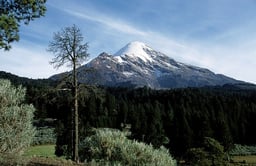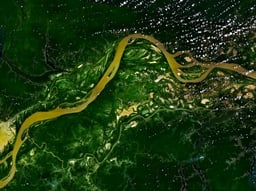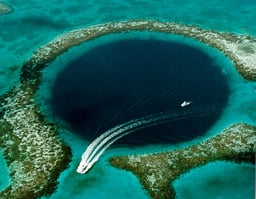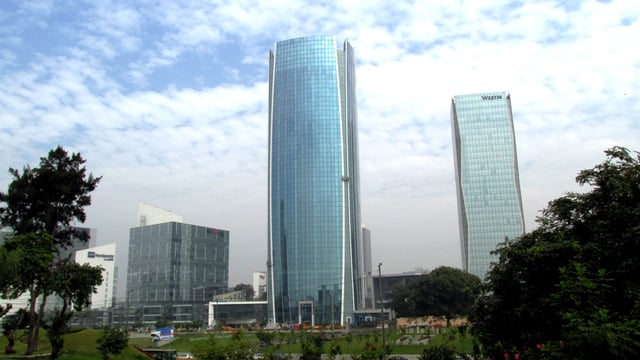Latin America

Latin America

| Area | 20,111,457 km2(7,765,077 sq mi)[4] |
|---|---|
| Population | 639,048,639 (2016 est.)[5][2] |
| Population density | 31/km2(80/sq mi) |
| Demonym | Latin American |
| Countries | 20[3] |
| Dependencies | 13 |
| Languages | Mainly: Spanish, Portuguese and French Others: Quechua, Haitian Creole, Mayan languages, Guaraní, Aymara, Nahuatl, Italian, German, English, Dutch, Polish, Ukrainian, Welsh, Yiddish, Chinese, Japanese |
| Time zones | UTC−2 to UTC−8 |
| Largest cities | (Metro areas)[6][7]
|
| UN M49 code | 419– Latin America019– Americas001– World |
Latin America[1] is a group of countries and dependencies in the Western Hemisphere where Romance languages such as Spanish, Portuguese, and French are predominantly spoken; it is broader than the terms Ibero-America or Hispanic America. The term "Latin America" was first used in an 1856 conference with the title "Initiative of the Americas. Idea for a Federal Congress of the Republics" (Iniciativa de la América. Idea de un Congreso Federal de las Repúblicas),[8] by the Chilean politician Francisco Bilbao. The term was used also by Napoleon III's French government in the 1860s as Amérique latine to consider French-speaking territories in the Americas (French Canadians, French Louisiana, French Guiana, Haiti, Guadeloupe, Martinique, Saint Martin, Saint Barthélemy), along with the larger group of countries where Spanish and Portuguese languages prevailed, including the Spanish-speaking portions of the United States (Southwestern United States and Florida)[9] Today, areas of Canada (such as Quebec) and the United States (with the exception of Puerto Rico)[10] where Spanish, Portuguese and French are predominant are typically not included in definitions of Latin America.
Latin America consists of 13 dependencies and 20 countries which cover an area that stretches from the northern border of Mexico to the southern tip of South America, including the Caribbean. It has an area of approximately 19,197,000 km2 (7,412,000 sq mi),[4] almost 13% of the Earth's land surface area. As of 2016, its population was estimated at more than 639 million[5][2] and in 2014, Latin America had a combined nominal GDP of US$5,573,397 million[11] and a GDP PPP of 7,531,585 million USD.[11][12]
| Area | 20,111,457 km2(7,765,077 sq mi)[4] |
|---|---|
| Population | 639,048,639 (2016 est.)[5][2] |
| Population density | 31/km2(80/sq mi) |
| Demonym | Latin American |
| Countries | 20[3] |
| Dependencies | 13 |
| Languages | Mainly: Spanish, Portuguese and French Others: Quechua, Haitian Creole, Mayan languages, Guaraní, Aymara, Nahuatl, Italian, German, English, Dutch, Polish, Ukrainian, Welsh, Yiddish, Chinese, Japanese |
| Time zones | UTC−2 to UTC−8 |
| Largest cities | (Metro areas)[6][7]
|
| UN M49 code | 419– Latin America019– Americas001– World |
Etymology and definitions
Origins

Presencia de América Latina (Presence of Latin America, 1964–65) is a 300 square meters (3,200 sq ft) mural at the hall of the Arts House of the University of Concepción, Chile. It is also known as Latin America's Integration.
The idea that a part of the Americas has a linguistic affinity with the Romance cultures as a whole can be traced back to the 1830s, in the writing of the French Saint-Simonian Michel Chevalier, who postulated that this part of the Americas was inhabited by people of a "Latin race", and that it could, therefore, ally itself with "Latin Europe", ultimately overlapping the Latin Church, in a struggle with "Teutonic Europe", "Anglo-Saxon America" and "Slavic Europe".[13] Further investigations of the concept of Latin America are by Michel Gobat in the American Historical Review,[14] the studies of Leslie Bethell,[15] and the monograph by Mauricio Tenorio-Trillo, Latin America: The Allure and Power of an Idea (2017).[16]
Historian John Leddy Phelan located the origins of “Latin America” in the French occupation of Mexico. His argument is that French imperialists used the concept of "Latin" America as a way to counter British imperialism, as well as to challenge the German threat to France.[17] The idea of a "Latin race" was then taken up by Latin American intellectuals and political leaders of the mid- and late-nineteenth century, who no longer looked to Spain or Portugal as cultural models, but rather to France.[18] French ruler Napoleon III had a strong interest in extending French commercial and political power in the region he and his business promoter Felix Belly called “Latin America” to emphasize the shared Latin background of France with the former colonies of Spain and Portugal. This led to Napoleon's failed attempt to take military control of Mexico in the 1860s.[9]
However, though Phelan thesis is still frequently mentioned in the U.S. academy, two Latin American historians, the Uruguayan Arturo Ardao and the Chilean Miguel Rojas Mix proved decades ago that the term "Latin America" was used earlier than Phelan claimed, and the first use of the term was completely opposite to support imperialist projects in the Americas. Ardao wrote about this subject in his book Génesis de la idea y el nombre de América latina (Genesis of the Idea and the Name of Latin America, 1980),[19] and Miguel Rojas Mix in his article "Bilbao y el hallazgo de América latina: Unión continental, socialista y libertaria" (Bilbao and the Finding of Latin America: a Continental, Socialist and Libertarian Union, 1986).[20] As Michel Gobat reminds in his article "The Invention of Latin America: A Transnational History of Anti-Imperialism, Democracy, and Race", "Arturo Ardao, Miguel Rojas Mix, and Aims McGuinness have revealed [that] the term 'Latin America' had already been used in 1856 by Central and South Americans protesting U.S. expansion into the Southern Hemisphere".[21] Edward Shawcross summarizes Ardao's and Rojas Mix's findings in the following way: "Ardao identified the term in a poem by a Colombian diplomat and intellectual resident in France, José María Torres Caicedo, published on 15 February 1857 in a French based Spanish-language newspaper, while Rojas Mix located it in a speech delivered in France by the radical liberal Chilean politician Francisco Bilbao in June 1856".[22]
By the late 1850s, the term was being used in local California newspapers such as El Clamor Publico by californios writing about America latina and latinoamerica, and identifying as latinos as the abbreviated term for their "hemispheric membership in la raza latina".[23]
So, regarding when the words "Latin" and "America" were combined for the first time in a printed work, the term "Latin America" was first used in 1856 in a conference by the Chilean politician Francisco Bilbao in Paris.[24] The conference had the title "Initiative of the America. Idea for a Federal Congress of Republics."[8] The following year the Colombian writer José María Torres Caicedo also used the term in his poem "The Two Americas".[25] Two events related with the U.S. played a central role in both works. The first event happened less than a decade before the publication of Bilbao's and Torres Caicedo works: the Mexican–American War, after which Mexico lost a third of its territory. The second event, the Walker affair, happened the same year both works were written: the decision by U.S. president Franklin Pierce to recognize the regime recently established in Nicaragua by American William Walker and his band of filibusters who ruled Nicaragua for nearly a year (1856–57) and attempted to reinstate slavery there, where it had been already abolished for three decades
In both Bilbao's and Torres Caicedo's works, the Mexican-American War and Walker's expedition to Nicaragua are explicitly mentioned as examples of dangers for the region. For Bilbao, "Latin America" was not a geographical concept, since he excluded Brazil, Paraguay and Mexico. Both authors also ask for the union of all Latin American countries as the only way to defend their territories against further foreign U.S. interventions. Both rejected also European imperialism, claiming that the return of European countries to non-democratic forms of government was another danger for Latin American countries, and used the same word to describe the state of European politics at the time: "despotism." Several years later, during the French invasion of Mexico, Bilbao wrote another work, "Emancipation of the Spirit in America," where he asked all Latin American countries to support the Mexican cause against France, and rejected French imperialism in Asia, Africa, Europe and the Americas. He asked Latin American intellectuals to search for their "intellectual emancipation" by abandoning all French ideas, claiming that France was: "Hypocrite, because she [France] calls herself protector of the Latin race just to subject it to her exploitation regime; treacherous, because she speaks of freedom and nationality, when, unable to conquer freedom for herself, she enslaves others instead!"[26] Therefore, as Michel Gobat puts it, the term Latin America itself had an "anti-imperial genesis," and their creators were far from supporting any form of imperialism in the region, or in any other place of the globe.
However, in France the term Latin America was used with the opposite intention. It was employed by the French Empire of Napoleon III during the French invasion of Mexico as a way to include France among countries with influence in the Americas and to exclude Anglophone countries. It played a role in his campaign to imply cultural kinship of the region with France, transform France into a cultural and political leader of the area, and install Maximilian of Habsburg as emperor of the Second Mexican Empire.[27] This term was also used in 1861 by French scholars in La revue des races Latines, a magazine dedicated to the Pan-Latinism movement.[28]

The 4 common subregions in Latin America
Latin America generally refers to territories in the Americas where the Spanish, Portuguese or French languages prevail: Mexico, most of Central and South America, and in the Caribbean, Cuba, the Dominican Republic, Haiti, Puerto Rico, and Quebec. Latin America is, therefore, defined as all those parts of the Americas that were once part of the Spanish, Portuguese and French Empires.[29] By this definition, Latin America is coterminous with Ibero-America when excluding the minority French-speaking territories ("Iberian America").[30]
The term is sometimes used more broadly to refer to all of the Americas south of the United States,[31] thus including the Guianas (French Guiana, Guyana, and Suriname), the Anglophone Caribbean (and Belize); the Francophone Caribbean; and the Dutch Caribbean. This definition emphasizes a similar socioeconomic history of the region, which was characterized by formal or informal colonialism, rather than cultural aspects (see, for example, dependency theory).[32] As such, some sources avoid this oversimplification by using the phrase "Latin America and the Caribbean" instead, as in the United Nations geoscheme for the Americas.[33][34][35]
In a more literal definition, which is close to the semantic origin, Latin America designates countries in the Americas where a Romance language (a language derived from Latin) predominates: Spanish, Portuguese, French, and the creole languages based upon these.[31]
The distinction between Latin America and Anglo-America is a convention based on the predominant languages in the Americas by which Romance-language and English-speaking cultures are distinguished. Neither area is culturally or linguistically homogeneous; in substantial portions of Latin America (e.g., highland Peru, Bolivia, Mexico, Guatemala), Native American cultures and, to a lesser extent, Amerindian languages, are predominant, and in other areas, the influence of African cultures is strong (e.g., the Caribbean basin – including parts of Colombia and Venezuela).
The term is not without controversy. Historian Mauricio Tenorio-Trillo explores at length the "allure and power" of the idea of Latin America. He remarks at the outset, "The idea of 'Latin America' ought to have vanished with the obsolescence of racial theory... But it is not easy to declare something dead when it can hardly be said to have existed," going on to say, "The term is here to stay, and it is important."[36] Following in the tradition of Chilean writer Francisco Bilbao, who excluded Brazil, Argentina and Paraguay from his early conceptualization of Latin America,[37] Chilean historian Jaime Eyzaguirre has criticized the term Latin America for "disguising" and "diluting" the Spanish character of a region (i.e. Hispanic America) with the inclusion of nations that according to him do not share the same pattern of conquest and colonization.[38]
Subregions and countries
Latin America can be subdivided into several subregions based on geography, politics, demographics and culture. If defined as all of the Americas south of the United States, the basic geographical subregions are North America, Central America, the Caribbean and South America;[39] the latter contains further politico-geographical subdivisions such as the Southern Cone, the Guianas and the Andean states. It may be subdivided on linguistic grounds into Hispanic America, Portuguese America and French America.
| Flag | Arms | Country | Capital(s) | Name(s) in official language(s) | Area (km²) | Population[5] (2016) | Population density (per km²) | Time(s) zone(s) | Subregion |
|---|---|---|---|---|---|---|---|---|---|
| Argentina | Buenos Aires | Argentina | 2,780,400 | 43,847,430 | 14.4 | UTC/GMT -3 hours | South America | ||
| Bolivia | Sucre and La Paz | Bolivia; Buliwya; Wuliwya; Volívia | 1,098,581 | 10,887,882 | 9 | UTC/GMT -4 hours | South America | ||
| Brazil | Brasília | Brasil | 8,515,767 | 207,652,865 | 23.6 | UTC/GMT -2 hours (Fernando de Noronha) UTC/GMT -3 hours (Brasília) UTC/GMT -4 hours (Amazonas) UTC/GMT -5 hours (Acre) | South America | ||
| Chile | Santiago | Chile | 756,096 | 17,909,754 | 23 | UTC/GMT -3 hours (Magallanes and Chilean Antarctica) UTC/GMT -4 hours (Continental Chile) UTC/GMT -5 hours (Easter Island) | South America | ||
| Colombia | Bogotá | Colombia | 1,141,748 | 48,653,419 | 41.5 | UTC/GMT -5 hours | South America | ||
| Costa Rica | San José | Costa Rica | 51,100 | 4,857,274 | 91.3 | UTC/GMT -6 hours | Central America | ||
| Cuba | Havana | Cuba | 109,884 | 11,475,982 | 100.6 | UTC/GMT -4 hours | Caribbean | ||
| Dominican Republic | Santo Domingo | República Dominicana | 48,442 | 10,648,791 | 210.9 | UTC/GMT -4 hours | Caribbean | ||
| Ecuador | Quito | Ecuador | 283,560 | 16,385,068 | 54.4 | UTC/GMT -5 hours | South America | ||
| El Salvador | San Salvador | El Salvador | 21,040 | 6,344,722 | 290.3 | UTC/GMT -6 hours | Central America | ||
| French Guiana* | Cayenne | Guyane | 83,534 | 275,713 | 3 | UTC/GMT -3 hours | South America | ||
| Guadeloupe* | Basse-Terre | Guadeloupe | 1,628 | 449,975 | 250 | UTC/GMT -4 hours | Caribbean | ||
| Guatemala | Guatemala City | Guatemala | 108,889 | 16,582,469 | 129 | UTC/GMT -6 hours | Central America | ||
| Haiti | Port-au-Prince | Haïti; Ayiti | 27,750 | 10,847,334 | 350 | UTC/GMT -4 hours | Caribbean | ||
| Honduras | Tegucigalpa | Honduras | 112,492 | 9,112,867 | 76 | UTC/GMT -6 hours | Central America | ||
| Martinique* | Fort-de-France | Martinique | 1,128 | 385,103 | 340 | UTC/GMT -4 hours | Caribbean | ||
| Mexico | Mexico City | México | 1,964 375 | 127,540,423 | 57 | UTC/GMT -5 hours (Zona Sureste) UTC/GMT -6 hours (Zona Centro) UTC/GMT -7 hours (Zona Pacífico) UTC/GMT -8 hours (Zona Noroeste) | North America | ||
| Nicaragua | Managua | Nicaragua | 130,375 | 6,149,928 | 44.3 | UTC/GMT -6 hours | Central America | ||
| Panama | Panama City | Panamá | 75,517 | 4,034,119 | 54.2 | UTC/GMT -5 hours | Central America | ||
| Paraguay | Asunción | Paraguay; Tetã Paraguái | 406,752 | 6,725,308 | 14.2 | UTC/GMT -4 hours | South America | ||
| Peru | Lima | Perú; Piruw | 1,285,216 | 31,773,839 | 23 | UTC/GMT -5 hours | South America | ||
| Puerto Rico* | San Juan | Puerto Rico | 9,104 | 3,667,903 | 397 | UTC/GMT -4 hours | Caribbean | ||
| Saint Barthélemy* | Gustavia | Saint-Barthélemy | 53.2 | 9,000[40] | 682 | UTC/GMT -4 hours | Caribbean | ||
| Saint Martin* | Marigot | Saint-Martin | 25 | 39,000 | 361 | UTC/GMT -4 hours | Caribbean | ||
| Saint Pierre and Miquelon* | Saint-Pierre | Saint-Pierre-et-Miquelon | 242 | 6,080 | 25 | UTC/GMT -3 hours, DST UTC/GMT -2 hours | North America | ||
| Uruguay | Montevideo | Uruguay | 176,215 | 3,444,006 | 18.87 | UTC/GMT -3 hours | South America | ||
| Venezuela | Caracas | Venezuela | 916,445 | 31,568,179 | 31.59 | UTC/GMT -4 hours | South America | ||
| Total | 20,111,699 | 626,747,000 |
*: Not a sovereign state
History
Pre-Columbian history
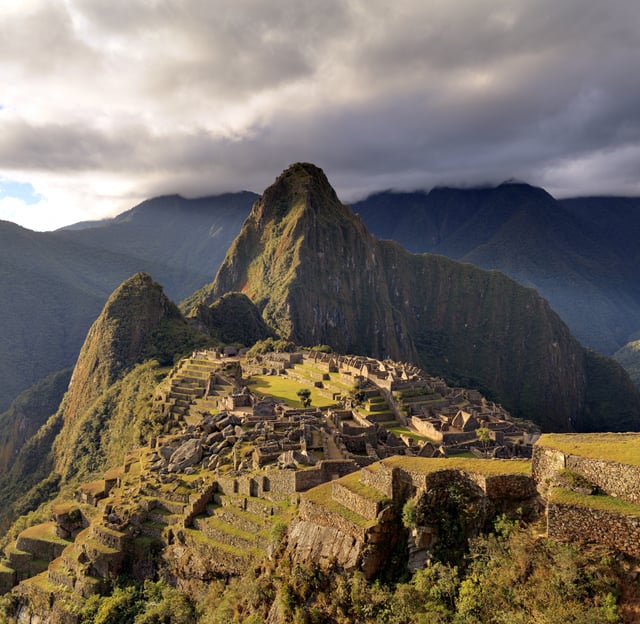
A view of Machu Picchu, a pre-Columbian Inca site in Peru.

Mayan archeological site Chichen Itza.
The earliest known settlement was identified at Monte Verde, near Puerto Montt in Southern Chile. Its occupation dates to some 14,000 years ago and there is some disputed evidence of even earlier occupation. Over the course of millennia, people spread to all parts of the continents. By the first millennium CE, South America's vast rainforests, mountains, plains and coasts were the home of tens of millions of people. The earliest settlements in the Americas are of the Las Vegas Culture[41] from about 8000 BCE and 4600 BCE, a sedentary group from the coast of Ecuador, the forefathers of the more known Valdivia culture, of the same era. Some groups formed more permanent settlements such as the Chibcha (or "Muisca" or "Muysca") and the Tairona groups. These groups are in the circum Caribbean region. The Chibchas of Colombia, the Quechuas and Aymaras of Bolivia were the three indigenous groups that settled most permanently.
The region was home to many indigenous peoples and advanced civilizations, including the Aztecs, Toltecs, Maya, and Inca. The golden age of the Maya began about 250, with the last two great civilizations, the Aztecs and Incas, emerging into prominence later on in the early fourteenth century and mid-fifteenth centuries, respectively. The Aztec empire was ultimately the most powerful civilization known throughout the Americas, until its downfall in part by the Spanish invasion.
European colonization
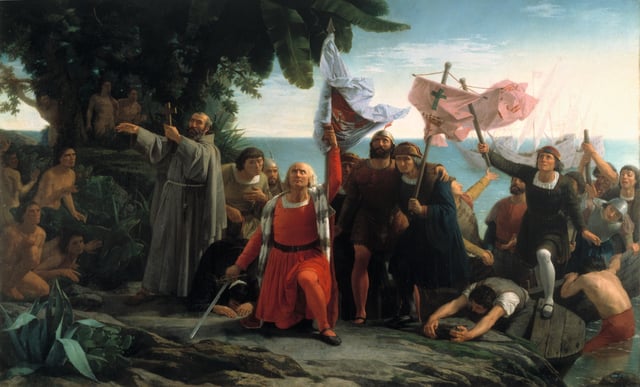
Romantic painting of Italian explorer Christopher Columbus arriving to the Americas (Primer desembarco de Cristóbal Colón en América), by Dióscoro Puebla (1862)
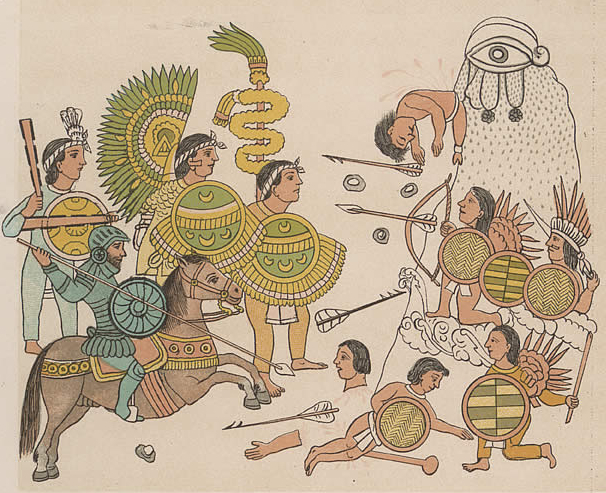
Cristóbal de Olid leads Spanish soldiers with Tlaxcalan allies against indigenous warriors during the European colonization of the Americas.

Spanish and Portuguese empires in 1790.
With the arrival of the Europeans following Christopher Columbus' voyages, the indigenous elites, such as the Incas and Aztecs, lost power to the heavy European invasion. Hernándo Cortés seized the Aztec elite's power with the help of local groups who had favored the Aztec elite, and Francisco Pizarro eliminated the Incan rule in Western South America. The European powers of Spain and Portugal colonized the region, which along with the rest of the uncolonized world, was divided into areas of Spanish and Portuguese control by the line of demarcation in 1494, which gave Spain all areas to the west, and Portugal all areas to the east (the Portuguese lands in South America subsequently becoming Brazil). By the end of the sixteenth century Spain and Portugal had been joined by others, including France, in occupying large areas of North, Central and South America, ultimately extending from Alaska to the southern tips of the Patagonia. European culture, customs and government were introduced, with the Roman Catholic Church becoming the major economic and political power to overrule the traditional ways of the region, eventually becoming the only official religion of the Americas during this period.
Epidemics of diseases brought by the Europeans, such as smallpox and measles, wiped out a large portion of the indigenous population. Historians cannot determine the number of natives who died due to European diseases, but some put the figures as high as 85% and as low as 25%. Due to the lack of written records, specific numbers are hard to verify. Many of the survivors were forced to work in European plantations and mines. Intermixing between the indigenous peoples and the European colonists was very common, and, by the end of the colonial period, people of mixed ancestry (mestizos) formed majorities in several colonies.
Slavery and forced labor in colonial Latin America
Indigenous peoples of the Americas in various European colonies were forced to work in European plantations and mines; along with African slaves who were also introduced in the proceeding centuries.
The Mita of Colonial Latin America was a system of forced labor imposed on the natives. First established by Viceroy Francisco de Toledo (1569–1581), the Mita was upheld by laws that designated how large draft levies were and how much money the workers would receive that was based on how many shifts each individual worker performed. Toledo established Mitas at Potosi and Huancavelica, where the Mitayos—the workers—would be reduced in number to a fraction of how many were originally assigned before the 1700s. While several villages managed to resist the Mita, others offered payment to colonial administrators as a way out. In exchange, free labor became available through volunteers, though the Mita was kept in place as workers like miners, for example, were paid low wages. The Spanish Crown had not made any ruling on the Mita or approved of it when Toledo first established it in spite of the uncertainty of the practice since the Crown could have gained benefits from it. However, the cortes of Spain later abolished it in 1812 once complaints of the Mita violating humanitarian rights were made. Yet complaints also came from: governors; landowners; native leaders known as Kurakas; and even priests, each of whom preferred other methods of economic exploitation. Despite its fall, the Mita made it to the 1800s.[42]
Another important group of slaves to mention were the slaves brought over from Africa. The first slaves came over with Christopher Columbus from the very beginning on his earliest voyages. However in the few hundred years, the Atlantic Slave trade would begin delivering slaves, imported by Spain and other colonizers, by the millions. Many of the large scale productions were run by forced slave labor. They were a part of sugar and coffee production, farming (beans, rice, corn, fruit, etc.), Mining, whale oil and multiple other jobs. Slaves were also house workers, servants, military soldiers, and much more. To say the least these people were property and treated as such. Though indigenous slaves existed, they were no match in quantity and lack of quality jobs when compared to the African slave. The slave population was massive compared to the better known slave ownership in the United States. After 1860 Brazil alone had imported over 4 million slaves, which only represented about 35% of the Atlantic slave trade. Despite the large number of slaves in Latin America, there was not as much reproduction of slaves amongst the population. Because most of the slaves then were African-born, they were more subject to rebellion. The United States involvement in the slave trade is well known amongst North America, however it hides a larger and in some ways crueler operation in the south which had a much longer history.[43]
Independence (1804–1825)
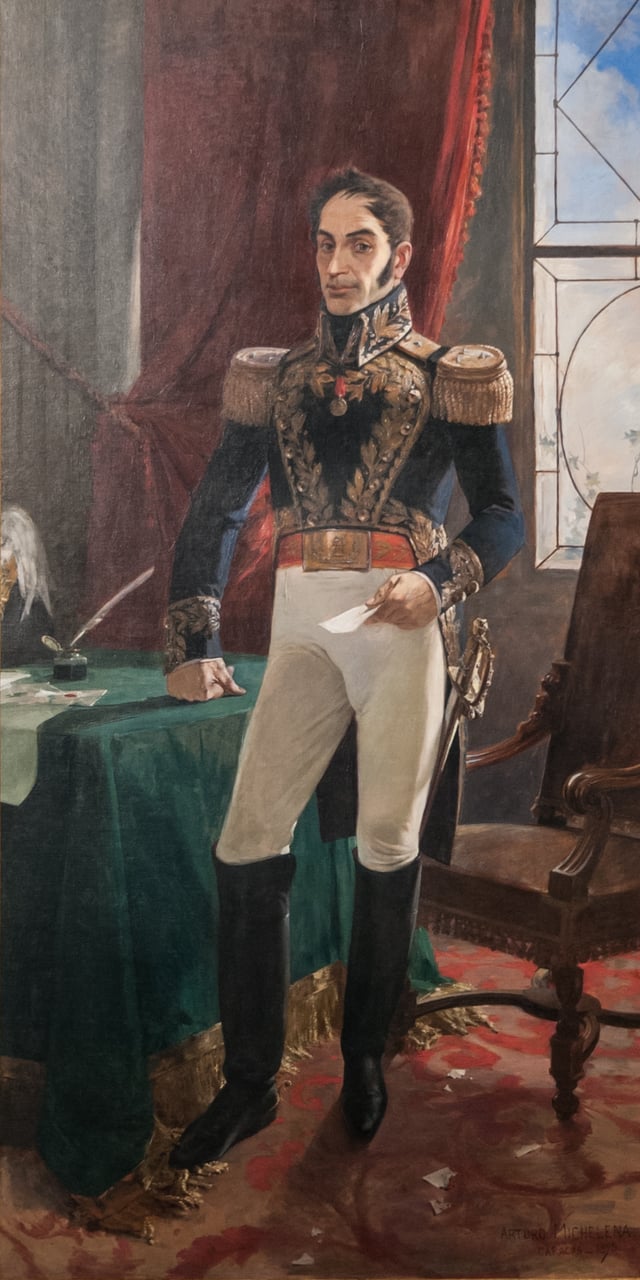
Simón Bolívar, Liberator of Venezuela, Colombia, Ecuador, Bolivia, Peru and Panama
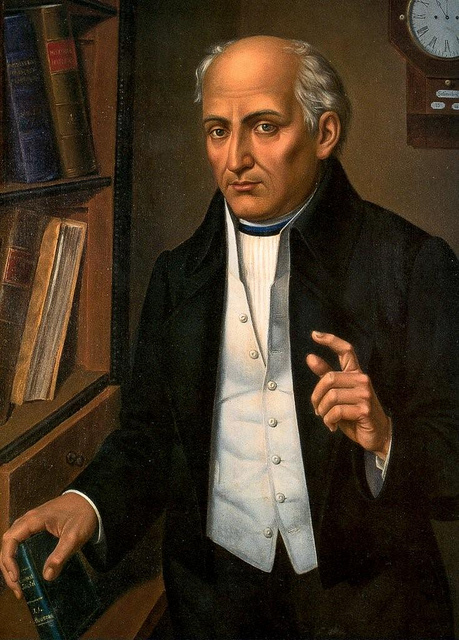
Miguel Hidalgo y Costilla was the first leader of the Mexican War of Independence.
In 1804, Haiti became the first Latin American nation to gain independence, following a violent slave revolt led by Toussaint L'ouverture on the French colony of Saint-Domingue. The victors abolished slavery. Haitian independence inspired independence movements in Spanish America.
By the end of the eighteenth century, Spanish and Portuguese power waned on the global scene as other European powers took their place, notably Britain and France. Resentment grew among the majority of the population in Latin America over the restrictions imposed by the Spanish government, as well as the dominance of native Spaniards (Iberian-born Peninsulares) in the major social and political institutions. Napoleon's invasion of Spain in 1808 marked a turning point, compelling Criollo elites to form juntas that advocated independence. Also, the newly independent Haiti, the second oldest nation in the New World after the United States, further fueled the independence movement by inspiring the leaders of the movement, such as Miguel Hidalgo y Costilla of Mexico, Simón Bolívar of Venezuela and José de San Martín of Argentina, and by providing them with considerable munitions and troops.
Fighting soon broke out between juntas and the Spanish colonial authorities, with initial victories for the advocates of independence. Eventually, these early movements were crushed by the royalist troops by 1810, including those of Miguel Hidalgo y Costilla in Mexico in the year 1810. Later on Francisco de Miranda in Venezuela by 1812. Under the leadership of a new generation of leaders, such as Simón Bolívar "The Liberator", José de San Martín of Argentina, and other Libertadores in South America, the independence movement regained strength, and by 1825, all Spanish America, except for Puerto Rico and Cuba, had gained independence from Spain. In the same year in Mexico, a military officer, Agustín de Iturbide, led a coalition of conservatives and liberals who created a constitutional monarchy, with Iturbide as emperor. This First Mexican Empire was short-lived, and was followed by the creation of a republic in 1823.
Independent Empire of Brazil

Declaration of the Brazilian independence by the later Emperor Pedro I on September 7, 1822

Pedro II, Emperor of Brazil between 1831 and 1889
The Brazilian War of Independence, which had already begun along other independent movements around the region, spread through northern, northeastern regions and in Cisplatina province.[44] With the last Portuguese soldiers surrendering on 8 March 1824,[45] Portugal officially recognized Brazil on 29 August 1825.[46]
On 7 April 1831, worn down by years of administrative turmoil and political dissensions with both liberal and conservative sides of politics, including an attempt of republican secession,[47] as well as unreconciled with the way that absolutists in Portugal had given to the succession of King John VI, Pedro I went to Portugal to reclaim his daughter's crown, abdicating the Brazilian throne in favor of his five-year-old son and heir (who thus became the Empire's second monarch, with the regnal title of Dom Pedro II).[48]
As the new Emperor could not exert his constitutional powers until he became of age, a regency was set up by the National Assembly.[49] In the absence of a charismatic figure who could represent a moderate face of power, during this period a series of localized rebellions took place, as the Cabanagem, the Malê Revolt, the Balaiada, the Sabinada, and the Ragamuffin War, which emerged from the dissatisfaction of the provinces with the central power, coupled with old and latent social tensions peculiar of a vast, slaveholding and newly independent nation state.[50] This period of internal political and social upheaval, which included the Praieira revolt, was overcome only at the end of the 1840s, years after the end of the regency, which occurred with the premature coronation of Pedro II in 1841.[51]
During the last phase of the monarchy, an internal political debate was centered on the issue of slavery. The Atlantic slave trade was abandoned in 1850,[52] as a result of the British' Aberdeen Act, but only in May 1888 after a long process of internal mobilization and debate for an ethical and legal dismantling of slavery in the country, was the institution formally abolished.[53]
On 15 November 1889, worn out by years of economic stagnation, in attrition with the majority of Army officers, as well as with rural and financial elites (for different reasons), the monarchy was overthrown by a military coup.[54]
Conservative–liberal conflicts in the 19th century
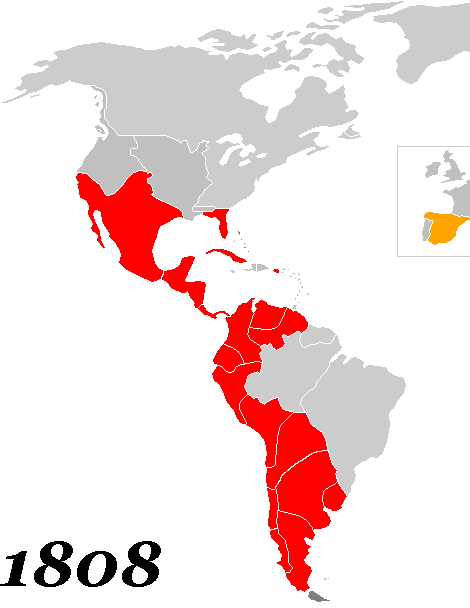
Development of Spanish American Independence Government under traditional Spanish law Loyal to Supreme Central Junta or Cortes American junta or insurrection movement Independent state declared or established Height of French control of the Peninsula
After the independence of many Latin American countries, there was a conflict between the people and the government, much of which can be reduced to the contrasting ideologies between liberalism and conservatism.[55] Conservatism was the dominant system of government prior to the revolutions and it was founded on having social classes, including governing by kings. Liberalists wanted to see a change in the ruling systems, and to move away from monarchs and social classes in order to promote equality.
When liberal Guadalupe Victoria became the first president of Mexico in 1824, conservatists relied on their belief that the state had been better off before the new government came into power, so, by comparison, the old government was better in the eyes of the Conservatives. Following this sentiment, the conservatives pushed to take control of the government, and they succeeded. General Santa Anna was elected president in 1833. The following decade, the Mexican–American War (1846–48) caused Mexico to lose a significant amount of territory to the United States. This loss led to a rebellion by the enraged liberal forces against the conservative government.
In 1837, conservative Rafael Carrera conquered Guatemala and separated from the Central American Union. The instability that followed the disintegration of the union led to the independence of the other Central American countries.
In Brazil, rural aristocrats were in conflict with the urban conservatives. Portuguese control over Brazilian ports continued after Brazil's independence. Following the conservative idea that the old government was better, urbanites tended to support conservatism because more opportunities were available to them as a result of the Portuguese presence.
Simón Bolívar became president of Gran Colombia in 1819 after the region gained independence from Spain. He led a military-controlled state. Citizens did not like the government's position under Bolívar: The people in the military were unhappy with their roles, and the civilians were of the opinion that the military had too much power. After the dissolution of Gran Colombia, New Grenada continued to have conflicts between conservatives and liberals. These conflicts were each concentrated in particular regions, with conservatives particularly in the southern mountains and the Valley of Cauca. In the mid-1840s some leaders in Caracas organized a liberal opposition. Antonio Leocadio Guzman was an active participant and journalist in this movement and gained much popularity among the people of Caracas.[56]
In Argentina, the conflict manifested itself as a prolonged civil war between unitarianas (i.e. centralists) and federalists, which were in some aspects respectively analogous to liberals and conservatives in other countries. Between 1832 and 1852, the country existed as a confederation, without a head of state, although the federalist governor of Buenos Aires province, Juan Manuel de Rosas, was given the powers of debt payment and international relations and exerted a growing hegemony over the country. A national constitution was only enacted in 1853, reformed in 1860, and the country reorganized as a federal republic led by a liberal-conservative elite.[57] After Uruguay achieved its independence, in 1828, a similar polarization crystallized between blancos and colorados, where the agrarian conservative interests were pitted against the liberal commercial interests based in Montevideo, and which eventually resulted in the Guerra Grande civil war (1839–1851).[58]
British influence in Latin America during the 19th century
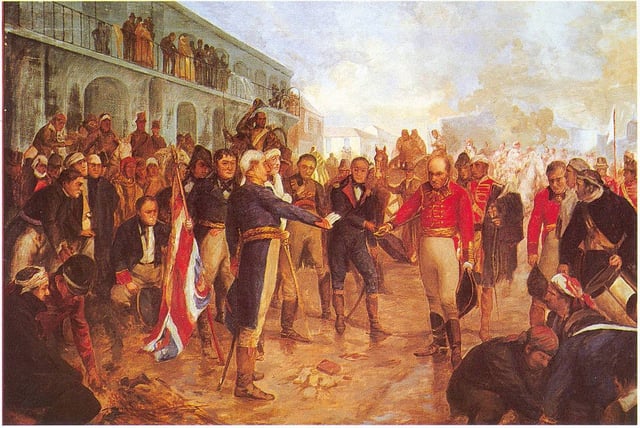
British invasions of the Río de la Plata. Beresford surrenders to Santiago de Liniers (1806).
Losing most of its North American colonies at the end of the 18th century left Great Britain in need of new markets to supply resources in the early 19th century.[59] In order to solve this problem, Great Britain turned to the Spanish colonies in South America for resources and markets. In 1806 a small British force surprise attacked the capitol of the viceroyalty in Río de la Plata.[60] As a result, the local garrison protecting the capitol was destroyed in an attempt to defend against the British conquest. The British were able to capture large amounts of precious metals, before a French naval force intervened on behalf of the Spanish King and took down the invading force. However, this caused much turmoil in the area as militia took control of the area from the viceroy. The next year the British attacked once again with a much larger force attempting to reach and conquer Montevideo.[61] They failed to reach Montevideo but succeeded in establishing an alliance with the locals. As a result, the British were able to take control of the Indian markets.
This newly gained British dominance hindered the development of Latin American industries and strengthened the dependence on the world trade network.[62] Britain now replaced Spain as the region's largest trading partner.[63] Great Britain invested significant capital in Latin America in order to develop the area as a market for processed goods.[64] From the early 1820s to 1850, the post-independence economies of Latin American countries were lagging and stagnant.[59] Eventually, enhanced trade among Britain and Latin America led to state development such as infrastructure improvements. These improvements included roads and railroads which grew the trades between countries and outside nations such as Great Britain.[65] By 1870, exports dramatically increased, attracting capital from abroad (including Europe and USA).[66]
French involvement in Latin America during the 19th century
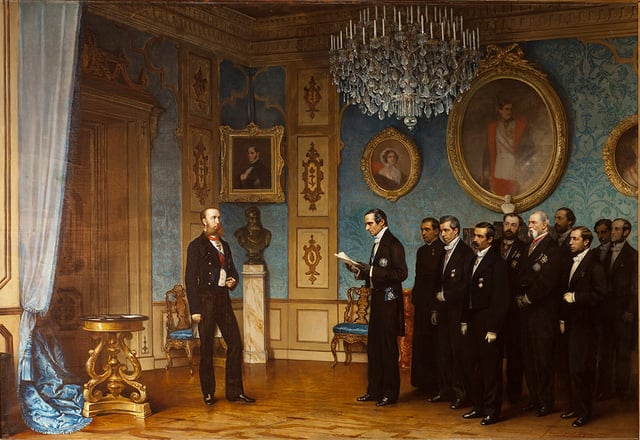
Maximilian receiving a Mexican delegation at Miramar Castle in Trieste, Italy
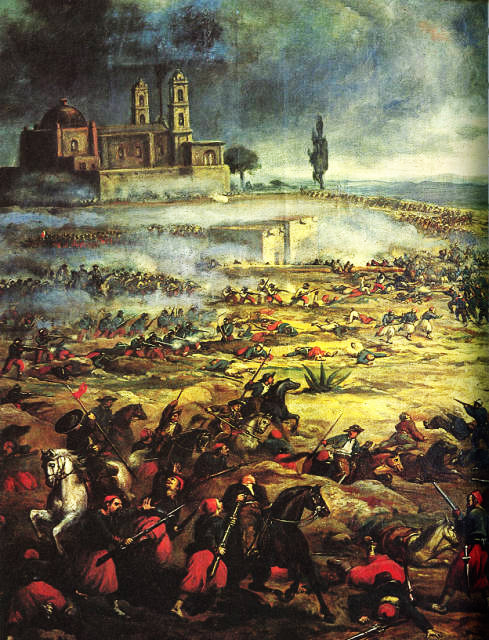
Painting depicting the Battle of Puebla in 1862
Between 1821 and 1910, Mexico battled through various civil wars between the established Conservative government and the Liberal reformists ("Mexico Timeline- Page 2)". On May 8, 1827 Baron Damas, the French Minister of Foreign Affairs, and Sebastián Camacho, a Mexican diplomat, signed an agreement called "The Declarations" which contained provisions regarding commerce and navigation between France and Mexico. At this time the French government did not recognize Mexico as an independent entity.[67] It was not until 1861 that the liberalist rebels, led by Benito Juárez, took control of Mexico City, consolidating liberal rule. However, the constant state of warfare left Mexico with a tremendous amount of debt owed to Spain, England, and France, all of whom funded the Mexican war effort (Neeno). As newly appointed president, Benito Juárez suspended payment of debts for next two years, to focus on a rebuilding and stabilization initiative in Mexico under the new government. On December 8, 1861, Spain, England and France landed in Veracruz in order to seize unpaid debts from Mexico. However, Napoleon III, with intentions of establishing a French client state to further push his economic interests, pressured the other two powers to withdraw in 1862 (Greenspan; "French Intervention in Mexico…").
France under Napoleon III remained and established Maximilian of Habsburg, Archduke of Austria, as Emperor of Mexico.[68] The march by the French to Mexico City enticed heavy resistance by the Mexican government, it resulted in open warfare. The Battle of Puebla in 1862 in particular presented an important turning point in which Ignacio Zaragoza led the Mexican army to victory as they pushed back the French offensive ("Timeline of the Mexican Revolution"). The victory came to symbolize Mexico's power and national resolve against foreign occupancy and as a result delayed France's later attack on Mexico City for an entire year (Cinco de Mayo (Mexican History)). With heavy resistance by Mexican rebels and the fear of United States intervention against France, forced Napoleon III to withdraw from Mexico, leaving Maximilian to surrender, where he would be later executed by Mexican troops under the rule of Porfirio Díaz.[69] Napoleon III's desire to expand France's economic empire influenced the decision to seize territorial domain over the Central American region. The port city of Veracruz, Mexico and France's desire to construct a new canal were of particular interest. Bridging both New World and East Asian trade routes to the Atlantic were key to Napoleon III's economic goals to the mining of precious rocks and the expansion of France's textile industry. Napoleon's fear of the United States' economic influence over the Pacific trade region, and in turn all New World economic activity, pushed France to intervene in Mexico under the pretense of collecting on Mexico's debt. Eventually France began plans to build the Panama Canal in 1881 until 1904 when the United States took over and proceeded with its construction and implementation ("Read Our Story").
American involvement in Latin America during the 19th century
Monroe Doctrine
The Monroe Doctrine was included in President James Monroe's 1823 annual message to Congress. The doctrine warns European nations that the United States will no longer tolerate any new colonization of Latin American countries. It was originally drafted to meet the present major concerns, but eventually became the precept of U.S. foreign policy in the Western Hemisphere. The doctrine was put into effect in 1865 when the U.S. government supported Mexican president, Benito Juárez, diplomatically and militarily. Some Latin American countries viewed the U.S. interventions, allowed by the Monroe Doctrine when the U.S. deems necessary, with suspicion.[70]
Another important aspect of United States involvement in Latin America is the case of the filibuster William Walker. In 1855, he traveled to Nicaragua hoping to overthrow the government and take the land for the United States. With only the aid of 56 followers, he was able to take over the city of Granada, declaring himself commander of the army and installing Patricio Rivas as a puppet president. However, Rivas's presidency ended when he fled Nicaragua; Walker rigged the following election to ensure that he became the next president. His presidency did not last long, however, as he was met with much opposition from political groups in Nicaragua and neighbouring countries. On May 1, 1857, Walker was forced by a coalition of Central American armies to surrender himself to a United States Navy officer who repatriated him and his followers. When Walker subsequently returned to Central America in 1860, he was apprehended by the Honduran authorities and executed.
Mexican–American War (1846–48)
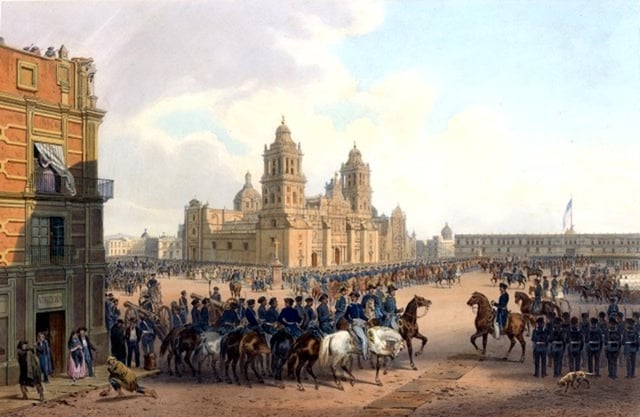
American occupation of Mexico City
The Mexican–American War, another instance of U.S. involvement in Latin America, was a war between the United States and Mexico that started in April 1846 and lasted until February 1848. The main cause of the war was the United States' annexation of Texas in 1845 and a dispute afterwards about whether the border between Mexico and the United States ended where Mexico claimed, at the Nueces River, or ended where the United States claimed, at the Rio Grande. Peace was negotiated between the United States and Mexico with the Treaty of Guadalupe Hidalgo, which stated that Mexico was to cede land which would later become part of California and New Mexico as well as give up all claims to Texas, for which the United States would pay $15,000,000. However, tensions between the two countries were still high and over the next six years things only got worse with raids along the border and attacks by Native Americans against Mexican citizens. To defuse the situation, the United States agreed to purchase 29,670 squares miles of land from Mexico for $10,000,000 so a southern railroad could be built to connect the Pacific and Atlantic coasts. This would become known as the Gadsden Purchase. A critical component of U.S. intervention in Latin American affairs took form in the Spanish–American War, which drastically affected the futures of Cuba and Puerto Rico in the Americas, as well as Guam and the Philippines, by dismantling some of the last remaining Spanish colonial possessions throughout the world.
From the United States of America interventions to the "Good Neighbor" policy
In the late 19th century and early 20th century, the U.S. banana importing companies United Fruit Company, Cuyamel Fruit Company (both ancestors of Chiquita), and Standard Fruit Company (now Dole), acquired large amounts of land in Central American countries like Guatemala, Honduras, and Costa Rica. The companies gained leverage over the governments and a ruling elite in these countries by dominating their economies and paying kickbacks, and exploited local workers. These countries came to be called banana republics.
The 1898 Spanish–American War resulted in the end of Spanish control in the Caribbean. A period of frequent U.S. intervention in Latin America followed, with the acquisition of the Panama Canal Zone in 1903, the so-called Banana Wars in Cuba, Haiti, Dominican Republic, Nicaragua, and Honduras; the Caco Wars in Haiti; and the so-called Border War with Mexico.
After World War I, U.S. interventionism diminished, culminating in President Franklin D. Roosevelt's Good Neighbor policy in 1933.
World wars (1914–1945)
World War I and the Zimmermann Telegram

The Zimmermann Telegram as it was sent from Washington to Ambassador Heinrich von Eckardt (German ambassador to Mexico)
The Zimmermann Telegram was a 1917 diplomatic proposal from the German Empire for Mexico to join an alliance with Germany in the event of the United States entering World War I against Germany. The proposal was intercepted and decoded by British intelligence. The revelation of the contents outraged the American public and swayed public opinion. President Woodrow Wilson moved to arm American merchant ships in order to defend themselves against German submarines, which had started to attack them. The news helped generate support for the United States declaration of war on Germany in April of that year.[71]
The message came as a coded telegram dispatched by the Foreign Secretary of the German Empire, Arthur Zimmermann, on January 16, 1917. The message was sent to the German ambassador of Mexico, Heinrich von Eckardt. Zimmermann sent the telegram in anticipation of the resumption of unrestricted submarine warfare by Germany on 1 February, an act which Germany presumed would lead to war. The telegram instructed Ambassador Eckardt that if the U.S. appeared certain to enter the war, he was to approach the Mexican Government with a proposal for a military alliance, with funding from Germany. As part of the alliance, Germany would assist Mexico in reconquering Texas and the Southwest. Eckardt was instructed to urge Mexico to help broker an alliance between Germany and Japan. Mexico, in the middle of the Mexican Revolution, far weaker militarily, economically and politically than the U.S., ignored the proposal; after the U.S. entered the war, it officially rejected it.
Brazil's participation in World War II
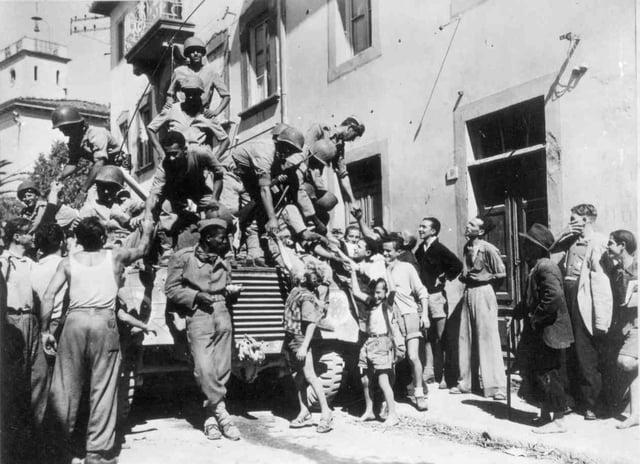
Brazilian soldiers greet Italian civilians in the city of Massarosa, September 1944. Brazil was the only independent Latin American country to send ground troops to fight in WWII.
After World War I, in which Brazil was an ally of the United States, Great Britain, and France, the country realized it needed a more capable army but didn't have the technology to create it. In 1919, the French Military Mission was established by the French Commission in Brazil. Their main goal was to contain the inner rebellions in Brazil. They tried to assist the army by bringing them up to the European military standard but constant civil missions did not prepare them for World War II.
Brazil's President, Getúlio Vargas, wanted to industrialize Brazil, allowing it to be more competitive with other countries. He reached out to Germany, Italy, France, and the United States to act as trade allies. Many Italian and German people immigrated to Brazil many years before World War II began thus creating a Nazi influence. The immigrants held high positions in government and the armed forces. It was recently found that 9,000 war criminals escaped to South America, including Croats, Ukrainians, Russians and other western Europeans who aided the Nazi war machine. Most, perhaps as many as 5,000, went to Argentina; between 1,500 and 2,000 are thought to have made it to Brazil; around 500 to 1,000 to Chile; and the rest to Paraguay and Uruguay.[72] It was not a secret that Vargas had an admiration for Hitler's Nazi Germany and its Führer. He even let German Luftwaffe build secret air forces around Brazil. This alliance with Germany became Brazil's second best trade alliance behind the United States.
Brazil continued to try to remain neutral to the United States and Germany because it was trying to make sure it could continue to be a place of interest for both opposing countries. Brazil attended continental meetings in Buenos Aires, Argentina (1936); Lima, Peru (1938); and Havana, Cuba (1940) that obligated them to agree to defend any part of the Americas if they were to be attacked. Eventually, Brazil decided to stop trading with Germany once Germany started attacking offshore trading ships resulting in Germany declaring a blockade against the Americas in the Atlantic Ocean. Furthermore, Germany also ensured that they would be attacking the Americas soon.
Once the German submarines attacked unarmed Brazilian trading ships, President Vargas met with the United States President Franklin D. Roosevelt to discuss how they could retaliate. On January 22, 1942, Brazil officially ended all relations with Germany, Japan, and Italy, becoming a part of the Allies.
The Brazilian Expeditionary Force was sent to Naples, Italy to fight for democracy. Brazil was the only Latin American country to send troops to Europe. Initially, Brazil wanted to only provide resources and shelter for the war to have a chance of gaining a high postwar status but ended up sending 25,000 men to fight.[73]
After World War II, the United States and Latin America continued to have a close relationship. For example, USAID created family planning programs in Latin America combining the NGOs already in place, providing the women in largely Catholic areas access to contraception.[74]
Mexico and World War II

The first Braceros arrive in Los Angeles, 1942.
Mexico entered World War II in response to German attacks on Mexican ships. The Potrero del Llano, originally an Italian tanker, had been seized in port by the Mexican government in April 1941 and renamed in honor of a region in Veracruz. It was attacked and crippled by the German submarine U-564 on 13 May 1942. The attack killed 13 of 35 crewmen.[75] On 20 May 1942, a second tanker, Faja de Oro, also a seized Italian ship, was attacked and sunk by the German submarine U-160, killing 10 of 37 crewmen. In response, President Manuel Ávila Camacho and the Mexican government declared war on the Axis powers on 22 May 1942.
A large part of Mexico's contribution to the war came through an agreement January 1942 that allowed Mexican nationals living in the United States to join the American armed forces. As many as 250,000 Mexicans served in this way.[76] In the final year of the war, Mexico sent one air squadron to serve under the Mexican flag: the Mexican Air Force's Escuadrón Aéreo de Pelea 201 (201st Fighter Squadron), which saw combat in the Philippines in the war against Imperial Japan.[77] Mexico was the only Latin-American country to send troops to the Asia-Pacific theatre of the war. In addition to those in the armed forces, tens of thousands of Mexican men were hired as farm workers in the United States during the war years through the Bracero program, which continued and expanded in the decades after the war.[78]
World War II helped spark an era of rapid industrialization known as the Mexican Miracle.[79] Mexico supplied the United States with more strategic raw materials than any other country, and American aid spurred the growth of industry.[80] President Ávila was able to use the increased revenue to improve the country's credit, invest in infrastructure, subsidize food, and raise wages.[81]
Involvement in World War II
There was a Nazi influence in certain parts of the region, but Jewish migration from Europe during the war continued. Only a few people recognized or knew about the Holocaust.[82] Furthermore, numerous military bases were built during the war by the United States, but some also by the Germans. Even now, unexploded bombs from the second world war that need to be made safe still remain.[83]
Cold War (1945–1992)
Economy
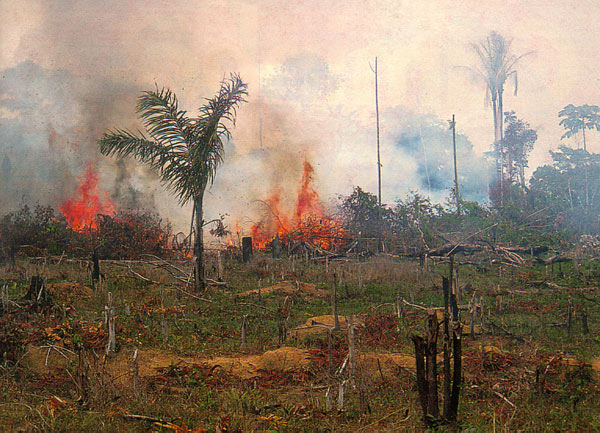
Burning forest in Brazil. The removal of forest to make way for cattle ranching was the leading cause of deforestation in the Brazilian Amazon rainforest from the mid-1960s. Soybeans have become one of the most important contributors to deforestation in the Brazilian Amazon.[84]
The Great Depression caused Latin America to grow at a slow rate, separating it from leading industrial democracies. The two world wars and U.S. Depression also made Latin American countries favor internal economic development, leading Latin America to adopt the policy of import substitution industrialization.[85] Countries also renewed emphasis on exports. Brazil began selling automobiles to other countries, and some Latin American countries set up plants to assemble imported parts, letting other countries take advantage of Latin America's low labor costs. Colombia began to export flowers, emeralds and coffee grains and gold, becoming the world's second-leading flower exporter.
Economic integration was called for, to attain economies that could compete with the economies of the United States or Europe. Starting in the 1960s with the Latin American Free Trade Association and Central American Common Market, Latin American countries worked toward economic integration.
In efforts to help regain global economic strength, the U.S. began to heavily assist countries involved in World War II at the expense of Latin America. Markets that were previously unopposed as a result of the war in Latin America grew stagnant as the rest of the world no longer needed their goods.
Reforms
Large countries like Argentina called for reforms to lessen the disparity of wealth between the rich and the poor, which has been a long problem in Latin America that stunted economic growth.[86]
Advances in public health caused an explosion of population growth, making it difficult to provide social services. Education expanded, and social security systems introduced, but benefits usually went to the middle class, not the poor. As a result, the disparity of wealth increased. Increasing inflation and other factors caused countries to be unwilling to fund social development programs to help the poor.
Bureaucratic authoritarianism
Bureaucratic authoritarianism was practised in Brazil after 1964, in Argentina, and in Chile under Augusto Pinochet, in a response to harsh economic conditions. It rested on the conviction that no democracy could take the harsh measures to curb inflation, reassure investors, and quicken economic growth quickly and effectively. Though inflation fell sharply, industrial production dropped with the decline of official protection.[86]
US relations

Chilean dictator Augusto Pinochet shaking hands with U.S. Secretary of State Henry Kissinger in 1976
After World War II and the beginning of a Cold War between the United States and the Soviet Union, US diplomats became interested in Asia, Africa, and Latin America, and frequently waged proxy wars against the Soviet Union in these countries. The US sought to stop the spread of communism. Latin American countries generally sided with the US in the Cold War period, even though they were neglected since the US's concern with communism were focused in Europe and Asia, not Latin America. Between 1946 and 1959 Latin America received only 2% of the United States foreign aid despite having poor conditions similar to the main recipients of The Marshall Plan.[87] Some Latin American governments also complained of the US support in the overthrow of some nationalist governments, and intervention through the CIA. In 1947, the US Congress passed the National Security Act, which created the National Security Council in response to the United States's growing obsession with anti-communism.[88]
In 1954, when Jacobo Arbenz of Guatemala accepted the support of communists and attacked holdings of the United Fruit Company, the US decided to assist Guatemalan counter-revolutionaries in overthrowing Arbenz.[89] These interventionist tactics featured the use of the CIA rather than the military, which was used in Latin America for the majority of the Cold War in events including the overthrow of Salvador Allende. Latin America was more concerned with issues of economic development, while the United States focused on fighting communism, even though the presence of communism was small in Latin America.[88]
Cuban Revolution
By 1959, Cuba was afflicted with a corrupt dictatorship under Batista, and Fidel Castro ousted Batista that year and set up the first communist state in the hemisphere. The United States imposed a trade embargo on Cuba, and combined with Castro's expropriation of private enterprises, this was detrimental to the Cuban economy.[85] Around Latin America, rural guerrilla conflict and urban terrorism increased, inspired by the Cuban example. The United States put down these rebellions by supporting Latin American countries in their counter-guerrilla operations through the Alliance for Progress launched by President John F. Kennedy. This thrust appeared to be successful. A Marxist, Salvador Allende, became president of Chile in 1970, but was overthrown three years later in a military coup backed by the United States. Despite civil war, high crime and political instability, most Latin American countries eventually adopted bourgeois liberal democracies while Cuba maintained its socialist system.
Bay of Pigs Invasion
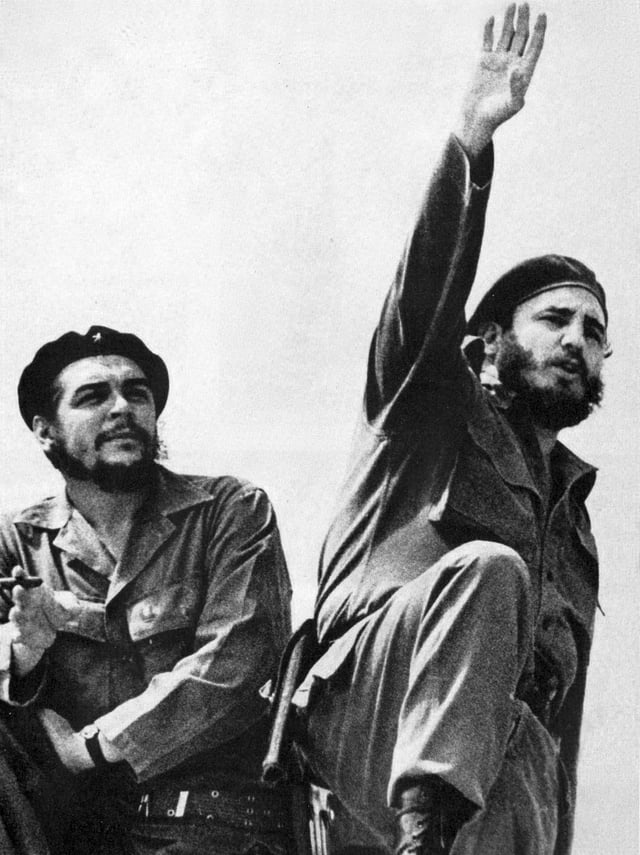
Che Guevara (left) and Castro, photographed by Alberto Korda in 1961
Encouraged by the success of Guatemala in the 1954 Guatemalan coup d'état,[90] in 1960, the U.S. decided to support an attack on Cuba by anti-Castro rebels. The Bay of Pigs invasion was an unsuccessful invasion of Cuba in 1961, financed by the U.S. through the CIA, to overthrow Fidel Castro. The incident proved to be very embarrassing for the new Kennedy administration.[91]
Alliance for Progress
President John F. Kennedy initiated the Alliance for Progress in 1961, to establish economic cooperation between the U.S. and Latin America. The Alliance would provide $20 billion for reform in Latin America, and counterinsurgency measures. Instead, the reform failed because of the simplistic theory that guided it and the lack of experienced American experts who could understand Latin American customs.[92]
Nicaraguan Revolution
Following the American occupation of Nicaragua in 1912, as part of the Banana Wars, the Somoza family political dynasty came to power, and would rule Nicaragua until their ouster in 1979 during the Nicaraguan Revolution. The era of Somoza family rule was characterized by strong U.S. support for the government and its military as well as a heavy reliance on U.S.-based multi-national corporations. The Nicaraguan Revolution (Spanish: Revolución Nicaragüense or Revolución Popular Sandinista) encompassed the rising opposition to the Somoza dictatorship in the 1960s and 1970s, the campaign led by the Sandinista National Liberation Front (FSLN) to violently oust the dictatorship in 1978–79, the subsequent efforts of the FSLN to govern Nicaragua from 1979 until 1990 and the Contra War which was waged between the FSLN and the Contras from 1981–1990.
The Revolution marked a significant period in Nicaraguan history and revealed the country as one of the major proxy war battlegrounds of the Cold War with the events in the country rising to international attention. Although the initial overthrow of the Somoza regime in 1978–79 was a bloody affair, the Contra War of the 1980s took the lives of tens of thousands of Nicaraguans and was the subject of fierce international debate.[93] During the 1980s both the FSLN (a Leftist collection of political parties) and the Contras (a rightist collection of counter-revolutionary groups) received large amounts of aid from the Cold War super-powers (respectively, the Soviet Union and the United States).
Washington Consensus

Roll-on/roll-off ships, such as this one pictured here at Miraflores locks, are among the largest ships to pass through the Panama Canal. The canal cuts across the Isthmus of Panama and is a key conduit for international maritime trade.
The set of specific economic policy prescriptions that were considered the "standard" reform package were promoted for crisis-wracked developing countries by Washington, D.C.-based institutions such as the International Monetary Fund (IMF), World Bank, and the US Department of the Treasury during the 1980s and 1990s.
In recent years, several Latin American countries led by socialist or other left wing governments – including Argentina and Venezuela – have campaigned for (and to some degree adopted) policies contrary to the Washington Consensus set of policies. (Other Latin countries with governments of the left, including Brazil, Mexico, Chile and Peru, have in practice adopted the bulk of the policies.) Also critical of the policies as actually promoted by the International Monetary Fund have been some US economists, such as Joseph Stiglitz and Dani Rodrik, who have challenged what are sometimes described as the "fundamentalist" policies of the International Monetary Fund and the US Treasury for what Stiglitz calls a "one size fits all" treatment of individual economies.
The term has become associated with neoliberal policies in general and drawn into the broader debate over the expanding role of the free market, constraints upon the state, and US influence on other countries' national sovereignty.
This politico-economical initiative was institutionalized in North America by 1994 NAFTA, and elsewhere in the Americas through a series of like agreements. The comprehensive Free Trade Area of the Americas project, however, was rejected by most South American countries at the 2005 4th Summit of the Americas.
Turn to the left
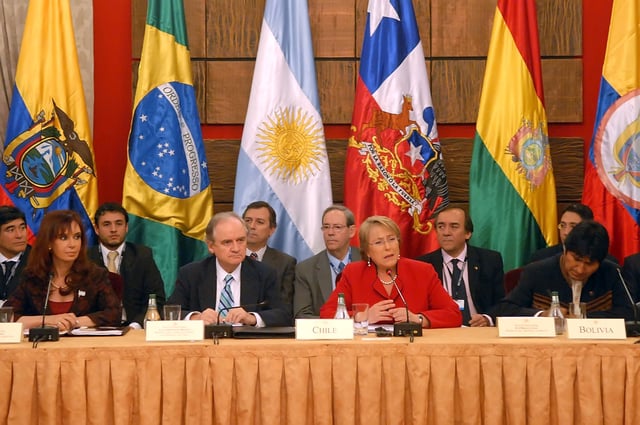
UNASUR summit in the Palacio de la Moneda, Santiago de Chile
In most countries, since the 2000s left-wing political parties have risen to power. The presidencies of Hugo Chávez in Venezuela, Ricardo Lagos and Michelle Bachelet in Chile, Lula da Silva and Dilma Rousseff in Brazil, Néstor Kirchner and his wife Cristina Fernández in Argentina, Tabaré Vázquez and José Mujica in Uruguay, Evo Morales in Bolivia, Daniel Ortega in Nicaragua, Rafael Correa in Ecuador, Fernando Lugo in Paraguay, Manuel Zelaya in Honduras (removed from power by a coup d'état), Mauricio Funes and Salvador Sánchez Cerén in El Salvador are all part of this wave of left-wing politicians who often declare themselves socialists, Latin Americanists, or anti-imperialists (often implying opposition to US policies towards the region). A development of this has been the creation of the eight-member ALBA alliance, or "The Bolivarian Alliance for the Peoples of Our America" (Spanish: Alianza Bolivariana para los Pueblos de Nuestra América) by some of the countries already mentioned. By June 2014, Honduras (Juan Orlando Hernández), Guatemala (Otto Pérez Molina), and Panama (Ricardo Martinelli) had right-wing governments.
Return of social movements

A view on globalization, titled Somos cultura que camina en un mundo globalizado ("We are a culture walking in a globalized world"). The mural is located in Humahuaca in the north of Argentina
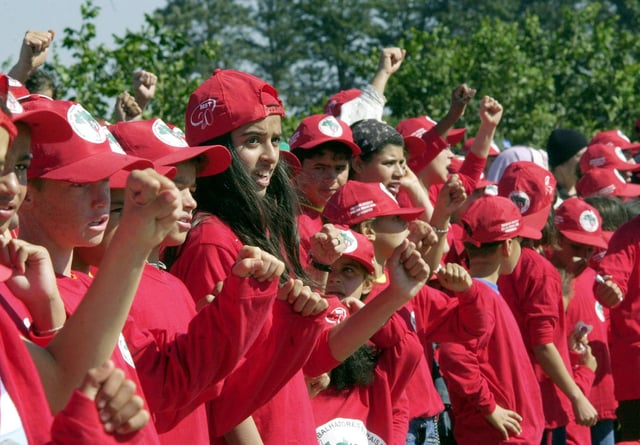
Children singing the Internationale, 20th anniversary of MST
In 1982, Mexico announced that it could not meet its foreign debt payment obligations, inaugurating a debt crisis that would "discredit" Latin American economies throughout the decade.[94] This debt crisis would lead to neoliberal reforms that would instigate many social movements in the region. A "reversal of development" reigned over Latin America, seen through negative economic growth, declines in industrial production, and thus, falling living standards for the middle and lower classes.[95] Governments made financial security their primary policy goal over social security, enacting new neoliberal economic policies that implemented privatization of previously national industries and informalization of labor.[94] In an effort to bring more investors to these industries, these governments also embraced globalization through more open interactions with the international economy.
Significantly, as democracy spread across much of Latin America, the realm of government became more inclusive (a trend that proved conducive to social movements), the economic ventures remained exclusive to a few elite groups within society. Neoliberal restructuring consistently redistributed income upward while denying political responsibility to provide social welfare rights, and though development projects took place throughout the region, both inequality and poverty increased.[94] Feeling excluded from these new projects, the lower classes took ownership of their own democracy through a revitalization of social movements in Latin America.
Both urban and rural populations had serious grievances as a result of the above economic and global trends and have voiced them in mass demonstrations. Some of the largest and most violent of these have been protests against cuts in urban services, such as the Caracazo in Venezuela and the Argentinazo in Argentina.[96]
Rural movements have made diverse demands related to unequal land distribution, displacement at the hands of development projects and dams, environmental and indigenous concerns, neoliberal agricultural restructuring, and insufficient means of livelihood. These movements have benefited considerably from transnational support from conservationists and INGOs. The Movement of Rural Landless Workers (MST) is perhaps the largest contemporary Latin American social movement.[96] As indigenous populations are primarily rural, indigenous movements account for a large portion of rural social movements, including the Zapatista rebellion in Mexico, the Confederation of Indigenous Nationalities of Ecuador (CONAIE), indigenous organizations in the Amazon region of Ecuador and Bolivia, pan-Mayan communities in Guatemala, and mobilization by the indigenous groups of Yanomami peoples in the Amazon, Kuna peoples in Panama, and Altiplano Aymara and Quechua peoples in Bolivia.[96] Other significant types of social movements include labor struggles and strikes, such as recovered factories in Argentina, as well as gender-based movements such as the Mothers of the Plaza de Mayo in Argentina and protests against maquila production, which is largely a women's issue because of how it draws on women for cheap labor.[96]
Modern era
The 2000s commodities boom caused positive effects for many Latin American economies. Another trend is the rapidly increasing importance of the relations with China.[97]
With the end of the commodity boom in the 2010s, economic stagnation or recession resulted in some countries. As a result, the left-wing governments of the Pink Tide lost support. The worst-hit was Venezuela, which is facing severe social and economic upheaval.
The corruption scandal of Odebrecht, a Brazilian conglomerate, has raised allegations of corruption across the region's governments (see Operation Car Wash). The bribery ring has become the largest corruption scandal in Latin American history.[98] As of July 2017, the highest ranking politicians charged were former Brazilian President Luiz Inácio Lula da Silva (arrested)[99] and former Peruvian Presidents Ollanta Humala (arrested) and Alejandro Toledo (fugitive, fled to the US).[100]
Demographics
| Historical populations | ||
|---|---|---|
| Year | Pop. | ±% |
| 1750 | 16,000,000 | — |
| 1800 | 24,000,000 | +50.0% |
| 1850 | 38,000,000 | +58.3% |
| 1900 | 74,000,000 | +94.7% |
| 1950 | 167,000,000 | +125.7% |
| 1999 | 511,000,000 | +206.0% |
| 2013 | 603,191,486 | +18.0% |
| Source: "UN report 2004 data" (PDF) [219] | ||
Largest cities
The following is a list of the ten largest metropolitan areas in Latin America.[6]
| City | Country | 2017 population | 2014 GDP (PPP, $million, USD) | 2014 GDP per capita, (USD) |
|---|---|---|---|---|
| Mexico City | 23,655,355 | $403,561 | $19,239 | |
| São Paulo | 23,467,354 | $430,510 | $20,650 | |
| Buenos Aires | 15,564,354 | $315,885 | $23,606 | |
| Rio de Janeiro | 14,440,345 | $176,630 | $14,176 | |
| Bogotá | 9,900,800 | $199,150 | $19,497 | |
| Lima | 9,752,000 | $176,447 | $16,530 | |
| Santiago | 7,164,400 | $171,436 | $23,290 | |
| Belo Horizonte | 6,145,800 | $95,686 | $17,635 | |
| Guadalajara | 4,687,700 | $80,656 | $17,206 | |
| Monterrey | 4,344,200 | $122,896 | $28,290 |
Ethnic groups
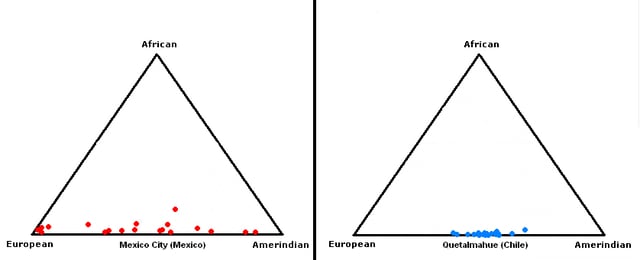
The Mexican mestizo population is the most diverse in Latin America, with people being either largely European or Amerindian rather than having a uniform admixture.[101]
The inhabitants of Latin America are of a variety of ancestries, ethnic groups, and races, making the region one of the most diverse in the world. The specific composition varies from country to country: some have a predominance of European-Amerindian or more commonly referred to as Mestizo or Castizo depending on the admixture, population; in others, Amerindians are a majority; some are dominated by inhabitants of European ancestry; and some countries' populations are primarily Mulatto. Various black, Asian and Zambo (mixed black and Amerindian) minorities are also identified regularly. People with European ancestry are the largest single group, and along with people of part-European ancestry, they combine to make up approximately 80% of the population,[102] or even more.[103]
According to Jon Aske:
Before Hispanics became such a 'noticeable' group in the U.S., the distinction between black and white was the major racial division and according to the one-drop rule adhered to by the culture at large, one drop of African ancestry usually meant that the person was Black. ... The notion of racial continuum and a separation of race (or skin color) and ethnicity, on the other hand, is the norm in most of Latin America. In the Spanish and Portuguese empires, racial mixing or miscegenation was the norm and something that the Spanish and Portuguese had grown rather accustomed to during the hundreds of years of contact with Arabs and North Africans in the Iberian peninsula. But, demographics may have made this inevitable as well. Thus, for example, of the approximately 13.5 million people who lived in the Spanish colonies in 1800 before independence only about one fifth were white. This contrasts with the U.S., where more than four fifths were whites (out of a population of 5.3 million in 1801, 900,000 were slaves, plus approximately 60,000 free blacks). ... The fact of the recognition of a racial continuum in Hispanic American (sic) does not mean that there wasn't discrimination, which there was, or that there wasn't an obsession with race, or 'castes', as they were sometimes called. ... In areas with large indigenous Amerindian populations, a racial mixture resulted, which is known in Spanish as mestizos ... who are a majority in Mexico, Central America and most of South America. Similarly, when African slaves were brought to the Caribbean region and Brazil, where there was very little indigenous presence left, unions between them and Spanish produced a population of mixed mulatos ... who are a majority of the population in many of those Spanish-speaking Caribbean basin countries (Cuba, Dominican Republic, Puerto Rico, Colombia, and Venezuela).
Aske has also written that:
Spanish colonization was rather different from later English, or British, colonization of North America. They had different systems of colonization and different methods of subjugation. While the English were primarily interested in grabbing land, the Spanish in addition had a mandate to incorporate the land's inhabitants into their society, something which was achieved by religious conversion and sexual unions which produced a new 'race' of mestizos, a mixture of Europeans and indigenous peoples. mestizos (sic) form the majority of the population in Mexico, Central America, and much of South America. Racial mixing or miscegenation, after all, was something that the Spanish and Portuguese had been accustomed to during the hundreds of years of contact with Arabs and North Africans. Similarly, later on, when African slaves were introduced into the Caribbean basin region, unions between them and Spaniards produced a population of mulatos, who are a majority of the population in the Caribbean islands (the Antilles) (Cuba, Dominican Republic, Puerto Rico), as well as other areas of the Caribbean region (Colombia, Venezuela and parts of the Central American Caribbean coast). mestizos (sic) and mulatos may not have always have been first class citizens in their countries, but they were never disowned in the way the outcomes of unions of Europeans and Native Americans were in the British colonies, where interracial marriages were taboo and one drop of Black or Amerindian blood was enough to make the person 'impure'.
In his famous 1963 book The Rise of the West, William Hardy McNeill wrote that:
Racially mixed societies arose in most of Spanish and Portuguese America, compounded in varying proportions from European, Indian, and Negro strands. Fairly frequent resort to manumission mitigated the hardships of slavery in those areas; and the Catholic church positively encouraged marriages between white immigrants and Indian women as a remedy for sexual immorality. However, in the southern English colonies and in most of the Caribbean islands, the importation of Negro slaves created a much more sharply polarized biracial society. Strong race feeling and the servile status of nearly all Negroes interdicted intermarriage, practically if not legally. Such discrimination did not prevent interbreeding; but children of mixed parentage were assigned to the status of their mothers. Mulattoes and Indian half-breeds were thereby excluded from the white community. In Spanish (and, with some differences, Portuguese) territories a more elaborate and less oppressive principle of racial discrimination established itself. The handful of persons who had been born in the homelands claimed topmost social prestige; next came those of purely European descent; while beneath ranged the various racial blends to form a social pyramid whose numerous racial distinctions meant that no one barrier could become as ugly and inpenetrable as that dividing whites from Negroes in the English, Dutch, and French colonies.
Thomas C. Wright, meanwhile, has written that:
The demographic makeup of colonial Latin America became more complex when, as the native population declined, the Portuguese, Spanish, and the French in Haiti turned to Africa for labor, as did the British in North America. The tricontinental heritage that characterizes Latin America, then, is shared by the United States, but even a casual examination reveals that the outcome of the complex interaction of different peoples has varied. While miscegenation among the three races certainly occurred in North America, it appears to have been much less common than in Latin America. Furthermore, offspring of such liaisons were not recognized as belonging to new, distinct racial categories in North America as they were in Latin America. The terms mestizo or mameluco, mulatto, the general term castas, and dozens of subcategories of racial identity frankly recognized the outcomes of interracial sexual activity in Latin America and established a continuum of race rather than the unrealistic absolute categories of white, black, or Indian as used in the United States. (The U.S. Census Bureau's forms did not allow individuals to list more than one race until 2000.)
Language

Linguistic map of Latin America. Spanish in green, Portuguese in orange, and French in blue.
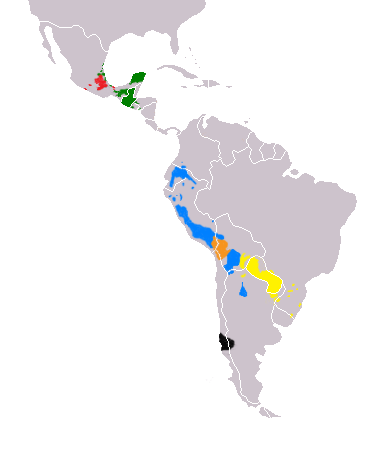
Quechua, Guaraní, Aymara, Náhuatl, Lenguas Mayas, Mapudungun
Spanish and Portuguese are the predominant languages of Latin America. Spanish is spoken as first language by about 60% of the population, Portuguese is spoken by about 34% of the population and about 6% of the population speak other languages such as Quechua, Mayan languages, Guaraní, Aymara, Nahuatl, English, French, Dutch and Italian. Portuguese is spoken only in Brazil (Brazilian Portuguese), the biggest and most populous country in the region. Spanish is the official language of most of the rest of the countries and territories on the Latin American mainland (Spanish language in the Americas), as well as in Cuba, Puerto Rico (where it is co-official with English), and the Dominican Republic. French is spoken in Haiti and in the French overseas departments of Guadeloupe, Martinique and Guiana, and the French overseas collectivity of Saint Pierre and Miquelon; it is also spoken by some Panamanians of Afro-Antillean descent. Dutch is the official language in Suriname, Aruba, Curaçao, and the Netherlands Antilles. (As Dutch is a Germanic language, these territories are not necessarily considered part of Latin America.) However, the native language of Aruba, Bonaire, and Curaçao, is Papiamento, a creole language largely based on Portuguese and Spanish and has a considerable influence coming from the Dutch language and Portuguese-based creole languages.
Amerindian languages are widely spoken in Peru, Guatemala, Bolivia, Paraguay and Mexico, and to a lesser degree, in Panama, Ecuador, Brazil, Colombia, Venezuela, Argentina, and Chile amongst other countries. In Latin American countries not named above, the population of speakers of indigenous languages tend to be very small or even non-existent (e.g. Uruguay). Mexico is possibly the only country that contains a wider variety of indigenous languages than any Latin American country, but the most spoken language is Nahuatl.
In Peru, Quechua is an official language, alongside Spanish and any other indigenous language in the areas where they predominate. In Ecuador, while holding no official status, the closely related Quichua is a recognized language of the indigenous people under the country's constitution; however, it is only spoken by a few groups in the country's highlands. In Bolivia, Aymara, Quechua and Guaraní hold official status alongside Spanish. Guaraní, along with Spanish, is an official language of Paraguay, and is spoken by a majority of the population (who are, for the most part, bilingual), and it is co-official with Spanish in the Argentine province of Corrientes. In Nicaragua, Spanish is the official language, but on the country's Caribbean coast English and indigenous languages such as Miskito, Sumo, and Rama also hold official status. Colombia recognizes all indigenous languages spoken within its territory as official, though fewer than 1% of its population are native speakers of these languages. Nahuatl is one of the 62 native languages spoken by indigenous people in Mexico, which are officially recognized by the government as "national languages" along with Spanish.
Other European languages spoken in Latin America include: English, by some groups in Puerto Rico, as well as in nearby countries that may or may not be considered Latin American, like Belize and Guyana, and spoken by descendants of British settlers in Argentina & Chile; German, in southern Brazil, southern Chile, portions of Argentina, Venezuela and Paraguay; Italian, in Brazil, Argentina, Venezuela, and Uruguay; Ukrainian, Polish and Russian in southern Brazil and Argentina; and Welsh, in southern Argentina.[108][109][110][111][112][113] Yiddish and Hebrew are possible to be heard around Buenos Aires and São Paulo especially.[114] Non-European or Asian languages include Japanese in Brazil, Peru, Bolivia, and Paraguay, Korean in Brazil, Argentina, Paraguay, and Chile, Arabic in Argentina, Brazil, Colombia, Venezuela, and Chile, and Chinese throughout South America.
In several nations, especially in the Caribbean region, creole languages are spoken. The most widely spoken creole language in Latin America and the Caribbean is Haitian Creole, the predominant language of Haiti; it is derived primarily from French and certain West African tongues with Amerindian, English, Portuguese and Spanish influences as well. Creole languages of mainland Latin America, similarly, are derived from European languages and various African tongues.
The Garifuna language is spoken along the Caribbean coast in Honduras, Guatemala, Nicaragua and Belize mostly by the Garifuna people a mixed race Zambo people who were the result of mixing between Indigenous Caribbeans and escaped Black slaves. Primarily an Arawakan language, it has influences from Caribbean and European languages.
Archaeologists have deciphered over 15 pre-Columbian distinct writing systems from mesoamerican societies. the ancient Maya had the most sophisticated textually written language, but since texts were largely confined to the religious and administrative elite, traditions were passed down orally. oral traditions also prevailed in other major indigenous groups including, but not limited to the Aztecs and other Nahuatl speakers, Quechua and Aymara of the Andean regions, the Quiché of Central America, the Tupi-Guaraní in today's Brazil, the Guaraní in Paraguay and the Mapuche in Chile.[115]
Religion

The Las Lajas Sanctuary in the southern Colombia, Department of Nariño.
The vast majority of Latin Americans are Christians (90%),[116] mostly Roman Catholics belonging to the Latin Church.[117] About 70% of the Latin American population consider themselves Catholic.[118]
Migration
Due to economic, social and security developments that are affecting the region in recent decades, the focus is now the change from net immigration to net emigration. About 10 million Mexicans live in the United States.[121] 31.7 million Americans listed their ancestry as Mexican as of 2010, or roughly 10% of the population.[122] During the initial stage of the Spanish colonization of the Philippines which were around the 1600s, about 16,500 soldiers levied from Peru and Mexico were sent together with 600 Spanish officers to fight wars, settle, colonize and build cities and Presidios in the Philippines.[123] These 16,500 Peruvians and Mexicans supplemented the Native Malay Population which then reached 667,612 people.[124] This initial group of Latin American soldier-settler founders had spread their genes among the sparesly populated Philippines.[125] This resulted into a spread of Latin American admixture among Filipinos as evidenced by a large number of Filipinos possessing Native American ancestry.[126] A Y-DNA compilation organized by the Genetic Company "Applied Biosystems" found that 13.33% of the Filipino Male Population sampled from across the country had Y-DNA of Latin American and Spanish origins.[127] Furthermore, according to a survey dated from 1870 conducted by German ethnologist Fedor Jagor of the population of Luzon island (Which holds half the citizens of the Philippines) 1/3rd of the people possess varying degrees of Spanish and Latin American ancestry.[128] According to the 2005 Colombian census or DANE, about 3,331,107 Colombians currently live abroad.[129] The number of Brazilians living overseas is estimated at about 2 million people.[130] An estimated 1.5 to two million Salvadorans reside in the United States.[131] At least 1.5 million Ecuadorians have gone abroad, mainly to the United States and Spain.[132] Approximately 1.5 million Dominicans live abroad, mostly in the United States.[133] More than 1.3 million Cubans live abroad, most of them in the United States.[134] It is estimated that over 800,000 Chileans live abroad, mainly in Argentina, the United States, Canada, Australia and Sweden.[135] An estimated 700,000 Bolivians were living in Argentina as of 2006 and another 33,000 in the United States.[136] Japanese Brazilian immigrants to Japan numbered 250,000 in 2004, constituting Japan's second-largest immigrant population. Their experiences bear similarities to those of Japanese Peruvian immigrants, who are often relegated to low income jobs typically occupied by foreigners.[137] Central Americans living abroad in 2005 were 3,314,300,[138] of which 1,128,701 were Salvadorans,[139] 685,713 were Guatemalans,[140] 683,520 were Nicaraguans,[141] 414,955 were Hondurans,[142] 215,240 were Panamanians[143] and 127,061 were Costa Ricans.[144]
For the period 2000–2005, Chile, Costa Rica, Panama, and Venezuela were the only countries with global positive migration rates, in terms of their yearly averages.[145]
As a result of the 2010 Haiti Earthquake and its social and economic impact, there was a significant migration of Haitians to other Latin American countries. During the presidency of Hugo Chávez and his successor Nicolás Maduro, over 3.2 million people fled Venezuela during the Venezuelan refugee crisis as socioeconomic conditions and the quality of life worsened.[146][147][148]
The countries of Latin America seek to strengthen links between migrants and their states of origin, while promoting their integration in the receiving state. These Emigrant Policies focus on the rights, obligations and opportunities for participation of emigrated citizens who already live outside the borders of the country of origin. Research on Latin America shows that the extension of policies towards migrants is linked to a focus on civil rights and state benefits that can positively influence integration in recipient countries. In addition, the tolerance of dual citizenship has spread more in Latin America than in any other region of the world.[149]
Education

World map indicating literacy rate by country in 2015 (2015 CIA World Factbook). Grey = no data.
Despite significant progress, education access and school completion remains unequal in Latin America. The region has made great progress in educational coverage; almost all children attend primary school and access to secondary education has increased considerably. Quality issues such as poor teaching methods, lack of appropriate equipment and overcrowding exist throughout the region. These issues lead to adolescents dropping out of the educational system early.[150] Most educational systems in the region have implemented various types of administrative and institutional reforms that have enabled reach for places and communities that had no access to education services in the early 1990s. Compared to prior generations, Latin American youth have seen an increase in their levels of education. On average, they have completed two years schooling more than their parents.[150]
However, there are still 23 million children in the region between the ages of 4 and 17 outside of the formal education system. Estimates indicate that 30% of preschool age children (ages 4–5) do not attend school, and for the most vulnerable populations, the poor and rural, this calculation exceeds 40 percent. Among primary school age children (ages 6 to 12), coverage is almost universal; however there is still a need to incorporate 5 million children in the primary education system. These children live mostly in remote areas, are indigenous or Afro-descendants and live in extreme poverty.[151]
Among people between the ages of 13 and 17 years, only 80% are full-time students in the education system; among them only 66% advance to secondary school. These percentages are lower among vulnerable population groups: only 75% of the poorest youth between the ages of 13 and 17 years attend school. Tertiary education has the lowest coverage, with only 70% of people between the ages of 18 and 25 years outside of the education system. Currently, more than half of low income children or living in rural areas fail to complete nine years of education.[151]
Crime and violence

2012 map of countries by homicide rate. As of 2015, the Latin American countries with the highest rates were El Salvador (108.64 per 100,000 people), Honduras (63.75) and Venezuela (57.15). The countries with the lowest rates were Chile (3.59), Cuba (4.72) and Argentina (6.53).
Latin America and the Caribbean have been cited by numerous sources to be the most dangerous regions in the world.[152][153] Studies have shown that Latin America contains the majority of the world's most dangerous cities. Many analysts attribute the reason to why the region has such an alarming crime rate and criminal culture is largely due to social and income inequality within the region, they say that growing social inequality is fueling crime in the region.[154] Many agree that the prison crisis will not be resolved until the gap between the rich and the poor is addressed.
Crime and violence prevention and public security are now important issues for governments and citizens in Latin America and the Caribbean region. Homicide rates in Latin America are the highest in the world. From the early 1980s through the mid-1990s, homicide rates increased by 50 percent. Latin America and the Caribbean experienced more than 2.5 million murders between 2000 and 2017.[155] There were a total of 63,880 murders in Brazil in 2018.[156]
The major victims of such homicides are young men, 69 percent of whom are between the ages of 15 and 19 years old. Countries with the highest homicide rate per year per 100,000 inhabitants as of 2015 were: El Salvador 109, Honduras 64, Venezuela 57, Jamaica 43, Belize 34.4, St. Kitts and Nevis 34, Guatemala 34, Trinidad and Tobago 31, the Bahamas 30, Brazil 26.7, Colombia 26.5, the Dominican Republic 22, St. Lucia 22, Guyana 19, Mexico 16, Puerto Rico 16, Ecuador 13, Grenada 13, Costa Rica 12, Bolivia 12, Nicaragua 12, Panama 11, Antigua and Barbuda 11, and Haiti 10.[157] Most of the top countries with the highest homicide rates are in Africa and Latin America. Countries in Central America, like El Salvador and Honduras, top the list of homicides in the world.[158]
Brazil has more overall homicides than any country in the world, at 50,108, accounting for one in 10 globally. Crime-related violence in Latin America represents the most threat to public health, striking more victims than HIV/AIDS or other infectious diseases.[159] Countries with lowest homicide rate per year per 100,000 inhabitants as of 2015 were: Chile 3, Peru 7, Argentina 7, Uruguay 8 and Paraguay 9.[157][160]
Economy
Size
According to Goldman Sachs' BRICS review of emerging economies, by 2050 the largest economies in the world will be as follows: China, United States, India, Japan, Germany, United Kingdom, Brazil and Mexico.[161]
| Country | Population[5] (2016, millions) | GDP (nominal)[162] (2015, billions US$) | GDP (PPP) (2015, billions US$) |
|---|---|---|---|
| 43.8 | 601.7 | 972.3 | |
| 10.9 | 33.5 | 73.9 | |
| 207.7 | 1,799.6 | 3,207.9 | |
| 17.9 | 240.0 | 424.3 | |
| 48.7 | 300.98 | 724.16 | |
| 4.9 | 51.6 | 74.1 | |
| 11.5 | N/A | N/A | |
| 10.6 | 66.6 | 147.6 | |
| 16.4 | 98.9 | 181.8 | |
| 6.3 | 25.7 | 52.9 | |
| 16.6 | 63.2 | 125.6 | |
| 10.8 | 8.8 | 19.0 | |
| 9.1 | 19.9 | 41.0 | |
| 127.5 | 1,161.0 | 2,220.1 | |
| 6.1 | 12.3 | 31.2 | |
| 4 | 47.5 | 82.2 | |
| 6.7 | 29.1 | 60.8 | |
| 31.8 | 179.9 | 385.4 | |
| 3.4 | 55.0 | 74.2 | |
| 31.6 | 131.9 | 491.6 | |
| Total | 577.8 | N/A | N/A |
Development
Over the past two centuries, Latin America’s GDP per capita has fluctuated around world average. However, there is a substantial gap between Latin America and the developed economies. In the Andean region this gap can be a consequence of low human capital among Inca Indios in Pre-Columbian times. It is evident that the numeracy value of Peruvian Indios in the early 16th century was just half of the numeracy of the Spanish and Portuguese. [163] Between 1820 and 2008, this gap widened from 0.8 to 2.7 times.[164] Since 1980, Latin America also lost growth versus the world average. Many nations such as those in Asia have joined others on a rapid economic growth path, but Latin America has grown at slower pace and its share of world output declined from 9.5% in 1980 to 7.8% in 2008.[165]
Standard of living
Latin America is the region with the highest levels of income inequality in the world.[166] The following table lists all the countries in Latin America indicating a valuation of the country's Human Development Index, GDP at purchasing power parity per capita, measurement of inequality through the Gini index, measurement of poverty through the Human Poverty Index, measurement of extreme poverty based on people living under 1.25 dollars a day, life expectancy, murder rates and a measurement of safety through the Global Peace Index. Green cells indicate the best performance in each category while red indicates the lowest.
| Country | HDI (2015 est.) | GDP (PPP) per capita in US$ (2015)[167] | Real GDP growth % (2015) | Income inequality Gini (2015)[168] | Extreme poverty % <1.25 US$ (2011)[169] | Youth literacy % (2015)[170] | Life expectancy (2016)[171] | Murder rate per 100,000 (2014)[172] | Peace GPI (2016)[173] |
|---|---|---|---|---|---|---|---|---|---|
| 0.827 | 20,170 | 2.6 | 43.6 | 0.9 | 99.2 | 78 | 6 | 1.957 | |
| 0.662 | 6,421 | 4.1 | 46.6 | 14.0 | 99.4 | 69 | 122012 | 2.038 | |
| 0.755 | 15,690 | −3.0 | 52.7 | 0.3 | 97.5 | 74 | 25 | 2.176 | |
| 0.847 | 25,564 | 2.3 | 50.8 | 0.8 | 98.9 | 79 | 4 | 1.635[173] | |
| 0.720 | 13,794 | 2.5 | 52.2[174] | 8.2 | 98.2 | 76 | 28 | 2.764 | |
| 0.766 | 15,318 | 3.0 | 48.6 | 0.7 | 98.3 | 79 | 10 | 1.699 | |
| 0.769 | N/A | N/A | N/A | N/A | 100.0 | 79 | 2.057 | ||
| 0.702 | 15,777 | 5.5 | 45.7 | 4.3 | 97.0 | 78 | 17 | 2.143 | |
| 0.732 | 11,168 | −0.6 | 46.6 | 5.1 | 98.7 | 77 | 8 | 2.020 | |
| 0.666 | 8,293 | 2.3 | 41.8 | 15.1 | 96.0 | 75 | 64 | 2.237 | |
| 0.627 | 7,721 | 3.8 | 52.4 | 16.9 | 87.4 | 72 | 31 | 2.270 | |
| 0.483 | 1,794 | 2.5 | 59.2 | 54.9 | 72.3 | 64 | 102012 | 2.066 | |
| 0.606 | 4,861 | 3.5 | 57.4 | 23.3 | 95.9 | 71 | 75 | 2.237 | |
| 0.756 | 18,335 | 2.3 | 48.1 | 8.4 | 98.5 | 77 | 16 | 2.557 | |
| 0.631 | 4,972 | 4.0 | 45.7 | 15.8 | 87.0 | 73 | 122012 | 1.975 | |
| 0.780 | 20,512 | 6.0 | 51.9 | 9.5 | 97.6 | 79 | 182012 | 1.837 | |
| 0.679 | 8,671 | 3.0 | 48.0 | 5.1 | 98.6 | 77 | 9 | 2.037 | |
| 0.734 | 12,077 | 2.4 | 45.3 | 5.9 | 97.4 | 74 | 7 | 2.057 | |
| 0.804 | 21,719 | 2.5 | 41.3 | 0.0 | 98.8 | 77 | 8 | 1.726 | |
| 0.762 | 15,892 | −10.0 | 44.8 | 3.5 | 98.5 | 75 | 62 | 2.651 |
Environment
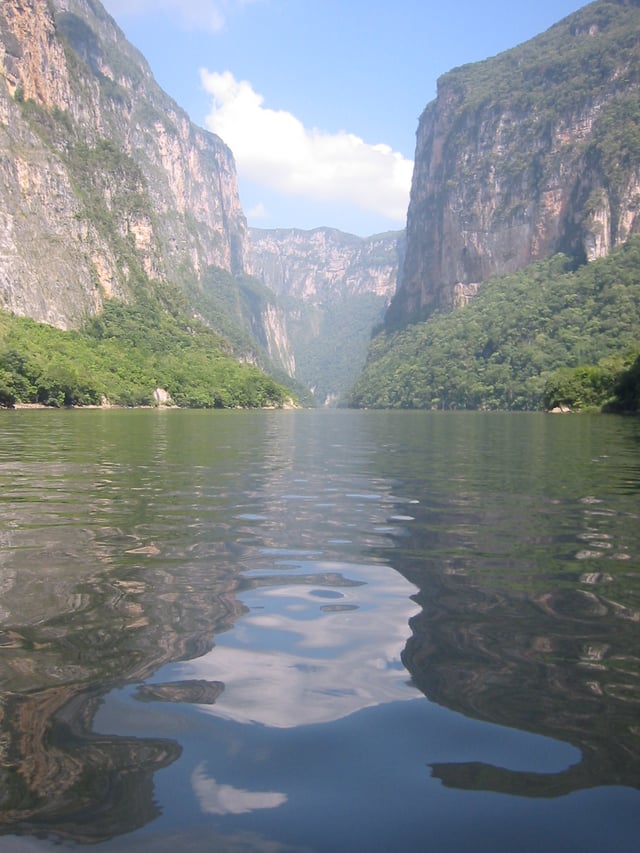
Sumidero Canyon, located in Chiapas, Mexico.
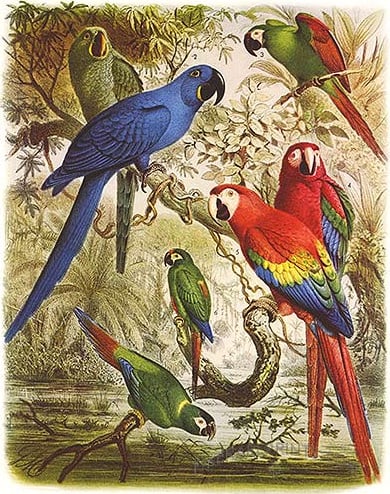
Glaucous macaw (behind hyacinth macaw) and other macaws. Macaws are long-tailed, often colorful New World parrots.[175]
| Country | Environmental performance[176] (2012) EPI | CO2 emissions[177] (2009) (tons of CO2 per capita) |
|---|---|---|
| 56.48 | 4.14 | |
| 54.57 | 1.31 | |
| 60.90 | 1.74 | |
| 55.34 | 3.84 | |
| 62.33 | 1.33 | |
| 69.03 | 1.37 | |
| 56.48 | 2.40 | |
| 52.44 | 1.79 | |
| 60.55 | 2.09 | |
| 52.08 | 1.10 | |
| 51.88 | 1.03 | |
| 41.15 | 0.24 | |
| 52.54 | 0.96 | |
| 49.11 | 3.72 | |
| 59.23 | 0.73 | |
| 57.94 | 2.10 | |
| 52.40 | 0.64 | |
| 50.29 | 1.32 | |
| 57.06 | 2.31 | |
| 55.62 | 5.45 |
Inequality
Wealth inequality in Latin America and the Caribbean remains a serious issue despite strong economic growth and improved social indicators over the past decade. A report released in 2013 by the UN Department of Economic and Social Affairs entitled Inequality Matters. Report of the World Social Situation, observed that: ‘Declines in the wage share have been attributed to the impact of labour-saving technological change and to a general weakening of labour market regulations and institutions.[178] Such declines are likely to affect individuals in the middle and bottom of the income distribution disproportionately, since they rely mostly on labour income.’ In addition, the report noted that ‘highly-unequal land distribution has created social and political tensions and is a source of economic inefficiency, as small landholders frequently lack access to credit and other resources to increase productivity, while big owners may not have had enough incentive to do so.[178][179]
Trade blocs
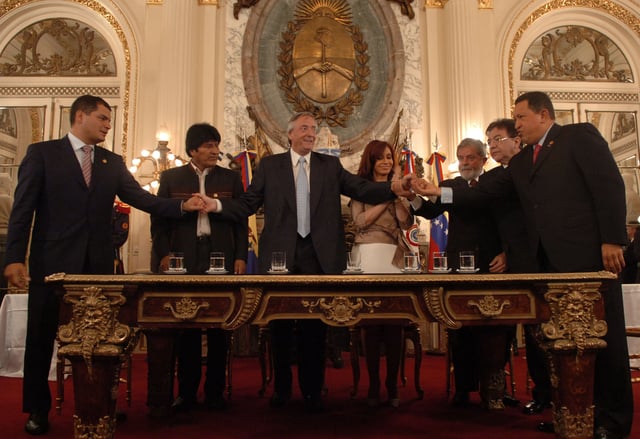
Rafael Correa, Evo Morales, Néstor Kirchner, Cristina Fernández, Luiz Inácio Lula da Silva, Nicanor Duarte, and Hugo Chávez at the signing of the founding charter of the Bank of the South
The major trade blocs (or agreements) in the region are the Pacific Alliance and Mercosur. Minor blocs or trade agreements are the G3 Free Trade Agreement, the Dominican Republic – Central America Free Trade Agreement (DR-CAFTA), the Caribbean Community (CARICOM) and the Andean Community of Nations (CAN). However, major reconfigurations are taking place along opposing approaches to integration and trade; Venezuela has officially withdrawn from both the CAN and G3 and it has been formally admitted into the Mercosur (pending ratification from the Paraguayan legislature). The president-elect of Ecuador has manifested his intentions of following the same path. This bloc nominally opposes any Free Trade Agreement (FTA) with the United States, although Uruguay has manifested its intention otherwise. Chile, Peru, Colombia and Mexico are the only four Latin American nations that have an FTA with the United States and Canada, both members of the North American Free Trade Agreement (NAFTA).
Tourism

Aerial view of Cancún. Mexico is the most visited country in Latin America and 6th in the world.
Income from tourism is key to the economy of several Latin American countries.[180] Mexico is the only Latin American country to be ranked in the top 10 worldwide in the number of tourist visits. It received by far the largest number of international tourists, with 39.3 million visitors in 2017, followed by Argentina, with 6.7 million; the Brazil, with 6.6 million; Chile, with 6.5 million; Dominican Republic, with 6.2 million; Cuba with 4.3 million; Peru and Colombia with 4.0 million. The World Tourism Organization reports the following destinations as the top six tourism earners for the year 2017: Mexico, with US$21,333 million; the Dominican Republic, with US$7,178 million; Brazil, with US$6,024 million; Colombia, with US$4,773 million; Argentina, with US$4,687 million; and Panama, with US$4,258 million.[181]
Places such as Cancún, Riviera Maya, Galápagos Islands, Punta Cana, Chichen Itza, Cartagena de Indias, Cabo San Lucas, Mexico City, Machu Picchu, Margarita Island, Acapulco, San Ignacio Miní, Santo Domingo, Buenos Aires, Salar de Uyuni, Rio de Janeiro, Punta del Este, Labadee, San Juan, São Paulo, La Habana, Panama City, Iguazú Falls, Puerto Vallarta, Poás Volcano National Park, Viña del Mar, Guanajuato City, Bogotá, Santa Marta, San Andrés, San Miguel de Allende, Lima, Guadalajara, Cuzco, Ponce and Perito Moreno Glacier are popular among international visitors in the region.
| Country | International tourist arrivals[182] (2017) (1000s) | International tourism receipts[182] (2017) (Millions of US$) | Tourism receipts (2011) (US$ per arrival) | Tourism receipts (2011) (US$ per capita) | Tourism receipts[183] (2003) (as % of exports) | Tourism receipts[184] (2003) (as % of GDP) | Direct and indirect employment[185] in tourism (2005) (%) | Tourism competitiveness[186] (2011) (TTCI) |
|---|---|---|---|---|---|---|---|---|
| 6,705 | 5,060 | 945 | 133 | 7.4 | 1.8 | 9.1 | 4.20 | |
| 959* | 784 | 31 | 9.4 | 2.2 | 7.6 | 3.35 | ||
| 6,589 | 5,809 | 1,207 | 34 | 3.2 | 0.5 | 7.0 | 4.36 | |
| 6,450 | 3,634 | 596 | 107 | 5.3 | 1.9 | 6.8 | 4.27 | |
| 4,027 | 4,773 | 873 | 45 | 6.6 | 1.4 | 5.9 | 3.94 | |
| 2,910 | 3,876 | 982 | 459 | 17.5 | 8.1 | 13.3 | 4.43 | |
| 4,297 | 3,045 | 872 | 194 | N/A | N/A | N/A | N/A | |
| 6,188 | 7,178 | 1,011 | 440 | 36.2 | 18.8 | 19.8 | 3.99 | |
| 1,608 | 1,657 | 734 | 58 | 6.3 | 1.5 | 7.4 | 3.79 | |
| 1,556 | 873 | 351 | 67 | 12.9 | 3.4 | 6.8 | 3.68 | |
| 1,660 | 1,550 | 1,102 | 94 | 16.0 | 2.6 | 6.0 | 3.82 | |
| 516* | 504 | 655 | 17 | 19.4 | 3.2 | 4.7 | N/A | |
| 908 | 686 | 753 | 92 | 13.5 | 5.0 | 8.5 | 3.79 | |
| 39,298 | 21,333 | 507 | 105 | 5.7 | 1.6 | 14.2 | 4.43 | |
| 1,787 | 841 | 356 | 65 | 15.5 | 3.7 | 5.6 | 3.56 | |
| 1,843 | 4,452 | 1,308 | 550 | 10.6 | 6.3 | 12.9 | 4.30 | |
| 1,537 | 603 | 460 | 37 | 4.2 | 1.3 | 6.4 | 3.26 | |
| 4,032 | 3,710 | 908 | 81 | 9.0 | 1.6 | 7.6 | 4.04 | |
| 3,674 | 2,540 | 765 | 643 | 14.2 | 3.6 | 10.7 | 4.24 | |
| 789* | 575* | 1,449 | 25 | 1.3 | 0.4 | 8.1 | 3.46 |
(*) Data for 2015 rather than 2017, as the newest data is currently unavailable.
Culture
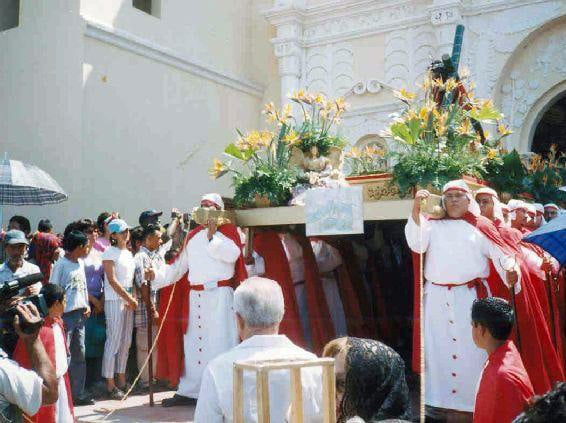
Roman Catholic Easter procession in Comayagua, Honduras
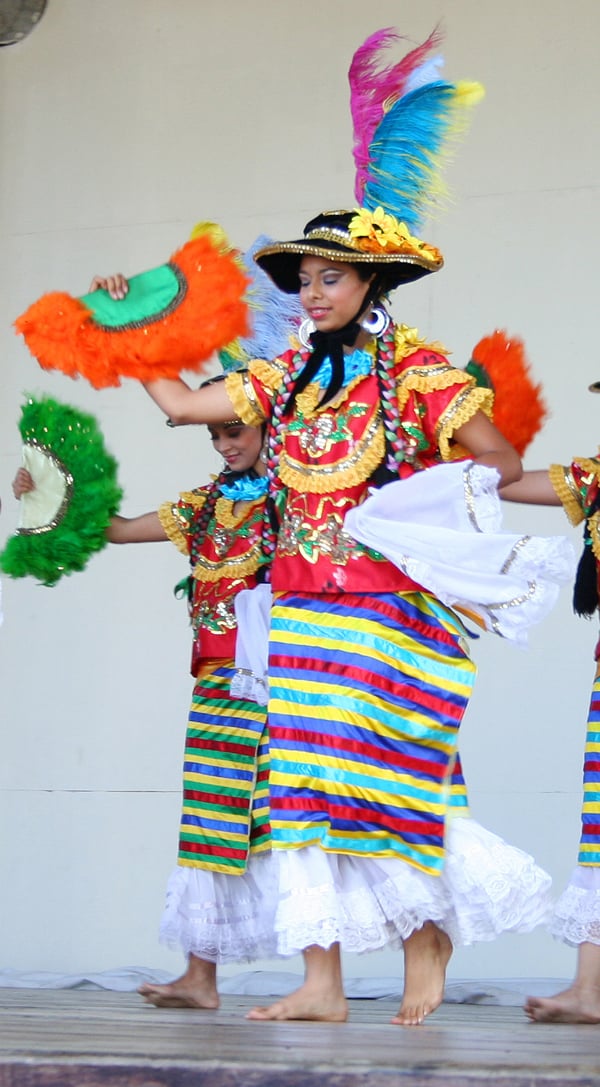
Nicaraguan women wearing the Mestizaje costume, which is a traditional costume worn to dance the Mestizaje dance. The costume demonstrates the Spanish influence upon Nicaraguan clothing.[187]
Latin American culture is a mixture of many cultural expressions worldwide. It is the product of many diverse influences:
Indigenous cultures of the people who inhabited the continent prior to European Colonization. Ancient and very advanced civilizations developed their own political, social and religious systems. The Mayas, the Aztecs and the Incas are examples of these. Indigenous legacies in music, dance, foods, arts and crafts, clothing, folk culture and traditions are very strong in Latin America. Linguistic effects on Spanish and Portuguese are also marked, such as in terms like pampa, taco, tamale, cacique.
Western civilization, in particular the culture of Europe, was brought mainly by the colonial powers – the Spanish, Portuguese and French – between the 16th and 19th centuries. The most enduring European colonial influence is language and Roman Catholicism. More recently, additional cultural influences came from the United States and Europe during the nineteenth and twentieth centuries, due to the growing influence of the former on the world stage and immigration from the latter. The influence of the United States is particularly strong in northern Latin America, especially Puerto Rico, which is an American territory. Prior to 1959, Cuba, who fought for its independence along American soldiers in the Spanish–American War, was also known to have a close socioeconomic relation with the United States. In addition, the United States also helped Panama become an independent state from Colombia and built the twenty-mile-long Panama Canal Zone in Panama which held from 1903 (the Panama Canal opened to transoceanic freight traffic in 1914) to 1999, when the Torrijos-Carter Treaties restored Panamanian control of the Canal Zone. South America experienced waves of immigration of Europeans, especially Italians, Spaniards, Portuguese, Germans, Austrians, Poles, Ukrainians, French, Dutch, Russians, Croatians, Lithuanians and Ashkenazi Jews. With the end of colonialism, French culture was also able to exert a direct influence in Latin America, especially in the realms of high culture, science and medicine.[188] This can be seen in any expression of the region's artistic traditions, including painting, literature and music, and in the realms of science and politics.
Due to the impact of Enlightenment ideals after the French revolution, a certain number of Iberian-American countries decriminalized homosexuality after France and French territories in the Americas in 1791. Some of the countries that abolished sodomy laws or banned any reference to state interference in consensual adult sexuality in the 19th century were Dominican Republic (1822), Brazil (1824), Peru (1836), Mexico (1871), Paraguay (1880), Argentina (1887), Honduras (1899), Guatemala and El Salvador. Today same-sex marriage is legal in Argentina, Brazil, Colombia, Costa Rica, Ecuador, Uruguay, and French overseas departments, as well as in several states of Mexico. Civil unions can be held in Chile.
African cultures, whose presence derives from a long history of New World slavery. Peoples of African descent have influenced the ethno-scapes of Latin America and the Caribbean. This is manifested for instance in music, dance and religion, especially in countries like Brazil, Uruguay, Honduras, Puerto Rico, Venezuela, Colombia, Panama, Haiti, Costa Rica, Dominican Republic, and Cuba.
Asian cultures, whose part of the presence derives from the long history of the Coolie trade mostly arriving during the 19th and 20th centuries, and most commonly Chinese workers in Peru and Venezuela. But also from Japanese and Korean immigration especially headed to Brazil. This has largely effected the cuisine, traditions including literature, art and lifestyles and politics. The effects of Asian influences have especially and mostly effected the nations of The Dominican Republic, Brazil, Cuba, Panama and Peru.
Art

Diego Rivera's mural depicting Mexico's history at the National Palace in Mexico City

Mural by Santiago Martinez Delgado in the Colombian Congress
Beyond the rich tradition of indigenous art, the development of Latin American visual art owed much to the influence of Spanish, Portuguese and French Baroque painting, which in turn often followed the trends of the Italian Masters. In general, this artistic Eurocentrism began to fade in the early twentieth century, as Latin Americans began to acknowledge the uniqueness of their condition and started to follow their own path.
From the early twentieth century, the art of Latin America was greatly inspired by the Constructivist Movement.[189] The Movement quickly spread from Russia to Europe and then into Latin America. Joaquín Torres García and Manuel Rendón have been credited with bringing the Constructivist Movement into Latin America from Europe.[190]
An important artistic movement generated in Latin America is muralism represented by Diego Rivera, David Alfaro Siqueiros, José Clemente Orozco and Rufino Tamayo in Mexico, Santiago Martinez Delgado and Pedro Nel Gómez in Colombia and Antonio Berni in Argentina. Some of the most impressive Muralista works can be found in Mexico, Colombia, New York City, San Francisco, Los Angeles and Philadelphia.
Painter Frida Kahlo, one of the most famous Mexican artists, painted about her own life and the Mexican culture in a style combining Realism, Symbolism and Surrealism. Kahlo's work commands the highest selling price of all Latin American paintings.[191]
The Venezuelan Armando Reverón, whose work begins to be recognized internationally, is one of the most important artists of the 20th century in South America; he is a precursor of Arte Povera and Happening. From the 60s the kinetic art emerges in Venezuela, its main representatives are Jesús Soto, Carlos Cruz-Diez, Alejandro Otero and Gego.
Film
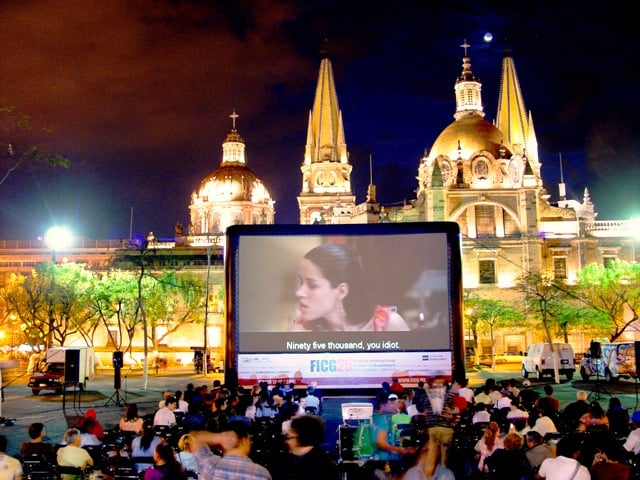
The Guadalajara International Film Festival is considered the most prestigious film festival in Latin America.

In 2015, Alejandro González Iñárritu became the second Mexican director in a row to win both the Academy Award and the Directors Guild of America Award for Best Director. He won his second Oscar in 2016 for The Revenant.
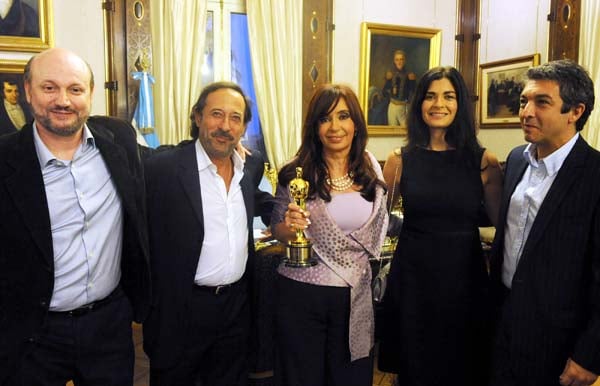
President Cristina Fernández with the film director Juan José Campanella and the cast of The Secret in Their Eyes (2009) with the Oscar for Best Foreign Language Film
Latin American film is both rich and diverse. Historically, the main centers of production have been Mexico, Argentina, Brazil, and Cuba. Latin American film flourished after sound was introduced in cinema, which added a linguistic barrier to the export of Hollywood film south of the border.[195]
Mexican cinema started out in the silent era from 1896 to 1929 and flourished in the Golden Era of the 1940s. It boasted a huge industry comparable to Hollywood at the time with stars such as María Félix, Dolores del Río, and Pedro Infante. In the 1970s, Mexico was the location for many cult horror and action movies. More recently, films such as Amores Perros (2000) and Y tu mamá también (2001) enjoyed box office and critical acclaim and propelled Alfonso Cuarón and Alejandro González Iñárritu to the front rank of Hollywood directors. Alejandro González Iñárritu directed in 2010 Biutiful and Birdman (2014), Alfonso Cuarón directed Harry Potter and the Prisoner of Azkaban in 2004 and Gravity (2013). Close friend of both, Guillermo del Toro, a top rank Hollywood director in Hollywood and Spain, directed Pan's Labyrinth (2006) and produced El Orfanato (2007). Carlos Carrera (The Crime of Father Amaro), and screenwriter Guillermo Arriaga are also some of the most known present-day Mexican film makers. Rudo y Cursi released in December (2008) in Mexico was directed by Carlos Cuarón.
Argentine cinema has also been prominenent since the first half of the 20th century and today averages over 60 full-length titles yearly. The industry suffered during the 1976–1983 military dictatorship; but re-emerged to produce the Academy Award winner The Official Story in 1985. A wave of imported U.S. films again damaged the industry in the early 1990s, though it soon recovered, thriving even during the Argentine economic crisis around 2001. Many Argentine movies produced during recent years have been internationally acclaimed, including Nueve reinas (2000), Son of the Bride (2001), El abrazo partido (2004), El otro (2007), the 2010 Foreign Language Academy Award winner El secreto de sus ojos and Wild Tales (2014).
In Brazil, the Cinema Novo movement created a particular way of making movies with critical and intellectual screenplays, a clearer photography related to the light of the outdoors in a tropical landscape, and a political message. The modern Brazilian film industry has become more profitable inside the country, and some of its productions have received prizes and recognition in Europe and the United States, with movies such as Central do Brasil (1999), Cidade de Deus (2002) and Tropa de Elite (2007).
Puerto Rican cinema has produced some notable films, such as Una Aventura Llamada Menudo, Los Diaz de Doris and Casi Casi. An influx of Hollywood films affected the local film industry in Puerto Rico during the 1980s and 1990s, but several Puerto Rican films have been produced since and it has been recovering.
Cuban cinema has enjoyed much official support since the Cuban revolution and important film-makers include Tomás Gutiérrez Alea.
Literature
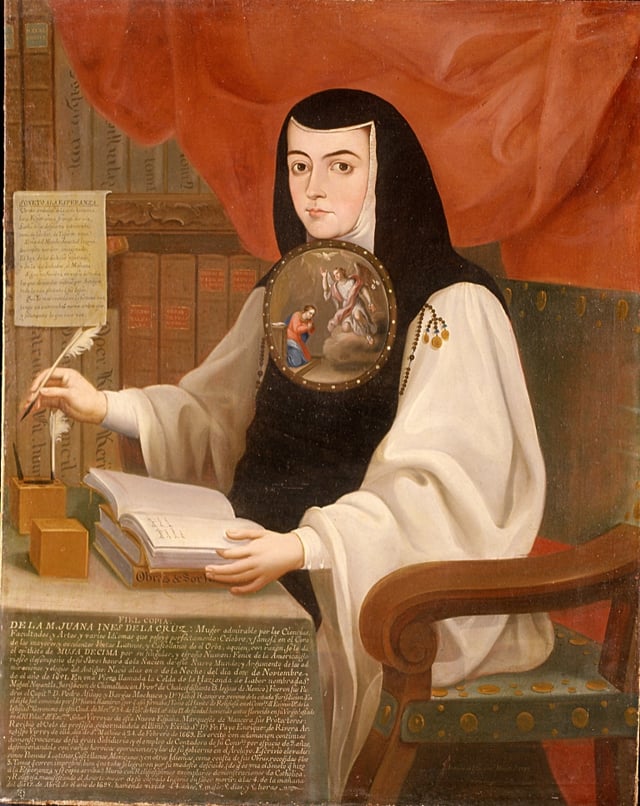
Sor Juana Inés de la Cruz in 1772 by Andrés de Islas
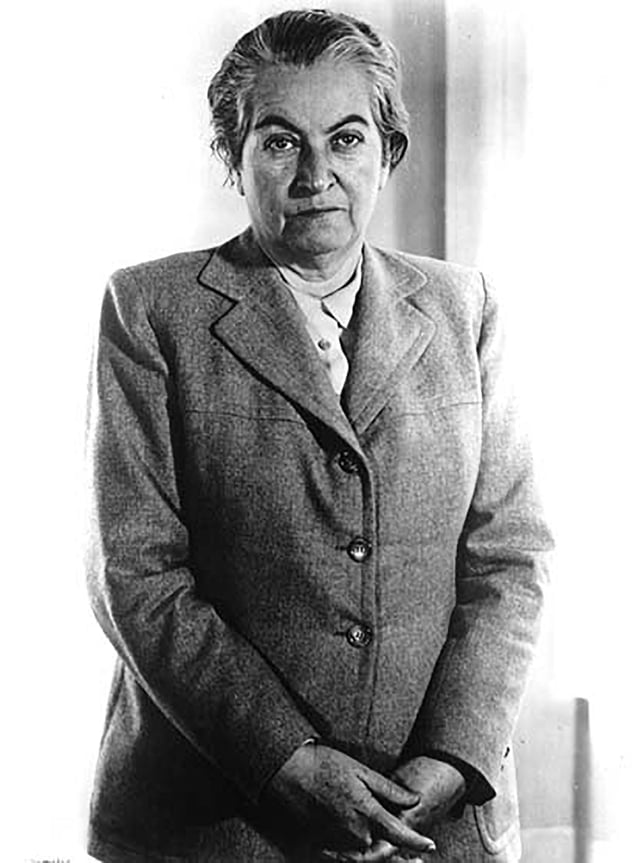
Chilean poet Gabriela Mistral, first Latin American to win a Nobel Prize in Literature, in 1945
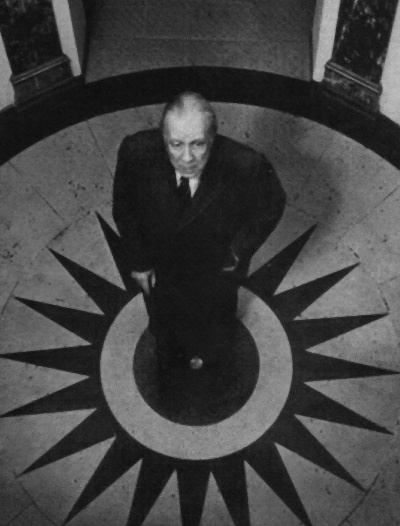
Argentine Jorge Luis Borges in L'Hôtel, Paris in 1969
Pre-Columbian cultures were primarily oral, though the Aztecs and Mayans, for instance, produced elaborate codices. Oral accounts of mythological and religious beliefs were also sometimes recorded after the arrival of European colonizers, as was the case with the Popol Vuh. Moreover, a tradition of oral narrative survives to this day, for instance among the Quechua-speaking population of Peru and the Quiché (K'iche') of Guatemala.
From the very moment of Europe's discovery of the continents, early explorers and conquistadores produced written accounts and crónicas of their experience – such as Columbus's letters or Bernal Díaz del Castillo's description of the conquest of Mexico. During the colonial period, written culture was often in the hands of the church, within which context Sor Juana Inés de la Cruz wrote memorable poetry and philosophical essays. Towards the end of the 18th Century and the beginning of the 19th, a distinctive criollo literary tradition emerged, including the first novels such as Lizardi's El Periquillo Sarniento (1816).
The 19th century was a period of "foundational fictions" (in critic Doris Sommer's words), novels in the Romantic or Naturalist traditions that attempted to establish a sense of national identity, and which often focussed on the indigenous question or the dichotomy of "civilization or barbarism" (for which see, say, Domingo Sarmiento's Facundo (1845), Juan León Mera's Cumandá (1879), or Euclides da Cunha's Os Sertões (1902)). The 19th century also witnessed the realist work of Machado de Assis, who made use of surreal devices of metaphor and playful narrative construction, much admired by critic Harold Bloom.
At the turn of the 20th century, modernismo emerged, a poetic movement whose founding text was Nicaraguan poet Rubén Darío's Azul (1888). This was the first Latin American literary movement to influence literary culture outside of the region, and was also the first truly Latin American literature, in that national differences were no longer so much at issue. José Martí, for instance, though a Cuban patriot, also lived in Mexico and the United States and wrote for journals in Argentina and elsewhere.
However, what really put Latin American literature on the global map was no doubt the literary boom of the 1960s and 1970s, distinguished by daring and experimental novels (such as Julio Cortázar's Rayuela (1963)) that were frequently published in Spain and quickly translated into English. The Boom's defining novel was Gabriel García Márquez's Cien años de soledad (1967), which led to the association of Latin American literature with magic realism, though other important writers of the period such as the Peruvian Mario Vargas Llosa and Carlos Fuentes do not fit so easily within this framework. Arguably, the Boom's culmination was Augusto Roa Bastos's monumental Yo, el supremo (1974). In the wake of the Boom, influential precursors such as Juan Rulfo, Alejo Carpentier, and above all Jorge Luis Borges were also rediscovered.
Contemporary literature in the region is vibrant and varied, ranging from the best-selling Paulo Coelho and Isabel Allende to the more avant-garde and critically acclaimed work of writers such as Diamela Eltit, Giannina Braschi, Ricardo Piglia, or Roberto Bolaño. There has also been considerable attention paid to the genre of testimonio, texts produced in collaboration with subaltern subjects such as Rigoberta Menchú. Finally, a new breed of chroniclers is represented by the more journalistic Carlos Monsiváis and Pedro Lemebel.
The region boasts six Nobel Prize winners: in addition to the two Chilean poets Gabriela Mistral (1945) and Pablo Neruda (1971), there is also the Guatemalan novelist Miguel Angel Asturias (1967), the Colombian writer Gabriel García Márquez (1982), the Mexican poet and essayist Octavio Paz (1990), and the Peruvian novelist Mario Vargas Llosa (2010).
Music and dance
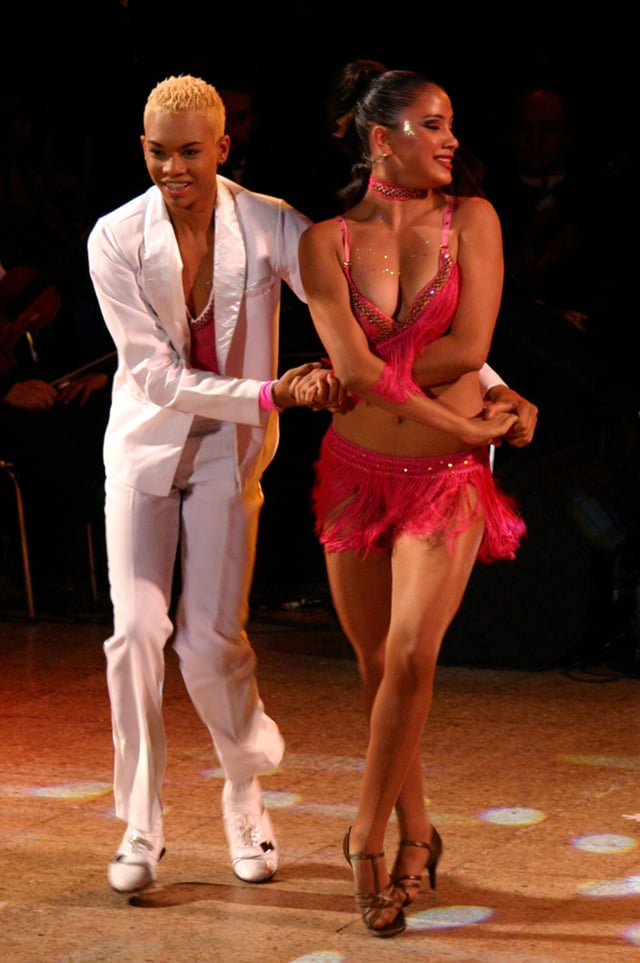
Salsa dancing in Cali, Colombia

Traditional Mexican dance Jarabe Tapatío

Brazilian singer Carmen Miranda helped popularize samba internationally.
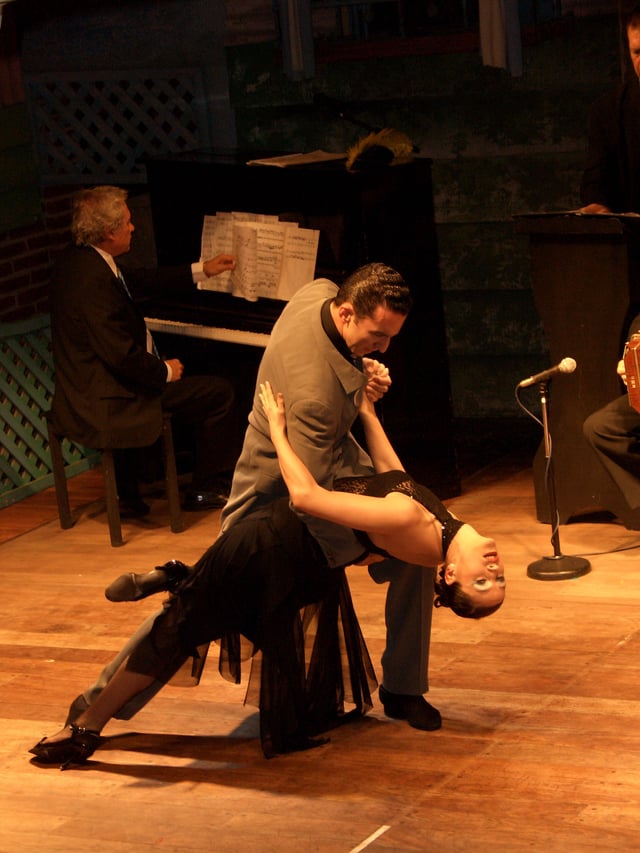
A couple dances tango.
Latin America has produced many successful worldwide artists in terms of recorded global music sales. Among the most successful have been Juan Gabriel (Mexico) only Latin American musician to have sold over 200 million records worldwide,[196] Gloria Estefan (Cuba), Carlos Santana, Luis Miguel (Mexico) of whom have sold over 90 million records, Shakira (Colombia) and Vicente Fernández (Mexico) with over 50 million records sold worldwide. Enrique Iglesias, although not a Latin American, has also contributed for the success of Latin music.
Other notable successful mainstream acts through the years, include RBD, Celia Cruz, Soda Stereo, Thalía, Ricky Martin, Maná, Marc Anthony, Ricardo Arjona, Selena, and Menudo.
Caribbean Hispanic music, such as merengue, bachata, salsa, and more recently reggaeton, from such countries as the Dominican Republic, Puerto Rico, Trinidad and Tobago, Cuba, and Panama, has been strongly influenced by African rhythms and melodies. Haiti's compas is a genre of music that is influenced by its Caribbean Hispanic counterparts, along with elements of jazz and modern sounds.[197][198]
Another well-known Latin American musical genre includes the Argentine and Uruguayan tango (with Carlos Gardel as the greatest exponent), as well as the distinct nuevo tango, a fusion of tango, acoustic and electronic music popularized by bandoneón virtuoso Ástor Piazzolla. Samba, North American jazz, European classical music and choro combined to form bossa nova in Brazil, popularized by guitarist João Gilberto with singer Astrud Gilberto and pianist Antonio Carlos Jobim.
Other influential Latin American sounds include the Antillean soca and calypso, the Honduran (Garifuna) punta, the Colombian cumbia and vallenato, the Chilean cueca, the Ecuadorian boleros, and rockoleras, the Mexican ranchera and the mariachi which is the epitome of Mexican soul, the Nicaraguan palo de Mayo, the Peruvian marinera and tondero, the Uruguayan candombe, the French Antillean zouk (derived from Haitian compas) and the various styles of music from pre-Columbian traditions that are widespread in the Andean region.
The classical composer Heitor Villa-Lobos (1887–1959) worked on the recording of native musical traditions within his homeland of Brazil. The traditions of his homeland heavily influenced his classical works.[199] Also notable is the recent work of the Cuban Leo Brouwer and guitar work of the Venezuelan Antonio Lauro and the Paraguayan Agustín Barrios. Latin America has also produced world-class classical performers such as the Chilean pianist Claudio Arrau, Brazilian pianist Nelson Freire and the Argentine pianist and conductor Daniel Barenboim. Brazilian opera soprano Bidu Sayão, one of Brazil's most famous musicians, was a leading artist of the Metropolitan Opera in New York City from 1937 to 1952.
Arguably, the main contribution to music entered through folklore, where the true soul of the Latin American and Caribbean countries is expressed. Musicians such as Yma Súmac, Chabuca Granda, Atahualpa Yupanqui, Violeta Parra, Víctor Jara, Jorge Cafrune, Facundo Cabral, Mercedes Sosa, Jorge Negrete, Luiz Gonzaga, Caetano Veloso, Susana Baca, Chavela Vargas, Simon Diaz, Julio Jaramillo, Toto la Momposina, Gilberto Gil, Maria Bethânia, Nana Caymmi, Nara Leão, Gal Costa, Ney Matogrosso as well as musical ensembles such as Inti Illimani and Los Kjarkas are magnificent examples of the heights that this soul can reach.
Latin pop, including many forms of rock, is popular in Latin America today (see Spanish language rock and roll).[200] A few examples are Café Tacuba, Soda Stereo, Maná, Rita Lee, Mutantes, Secos e Molhados Legião Urbana, Titãs, Paralamas do Sucesso, Cazuza, Barão Vermelho, Skank, Miranda!, Cansei de Ser Sexy or CSS, and Bajo Fondo.
More recently, reggaeton, which blends Jamaican reggae and dancehall with Latin America genres such as bomba and plena, as well as hip hop, is becoming more popular, in spite of the controversy surrounding its lyrics, dance steps (Perreo) and music videos. It has become very popular among populations with a "migrant culture" influence – both Latino populations in the United States, such as southern Florida and New York City, and parts of Latin America where migration to the United States is common, such as Trinidad and Tobago, Dominican Republic, Colombia, Ecuador, El Salvador, and Mexico.[201]
World Heritage sites
The following is a list of the ten countries with the most World Heritage Sites in Latin America.[202]
See also
Agroecology in Latin America
American (word)
Americas (terminology)
Aridoamerica
Caribbean Association of Caribbean States Organisation of Eastern Caribbean States
Central American Integration System
Diaspora Hispanic and Latino Americans Latin American Australians Latin American British Latin American Canadians Hispanic Latino
French America
Hispanic America
Ibero-America
Latin America and the Caribbean (region)
Latin America and the League of Nations
Latin American integration
Latin American studies
Latin Americans Amerindians Criollo Afro-Latin Americans Asian Latin Americans Mestizos Mulatto White Latin Americans Zambo
Latin America–United States relations
America's Backyard
List of Latin Americans
Mesoamerica
Middle America (Americas)
Northern America
Romance-speaking world
Water supply and sanitation in Latin America
